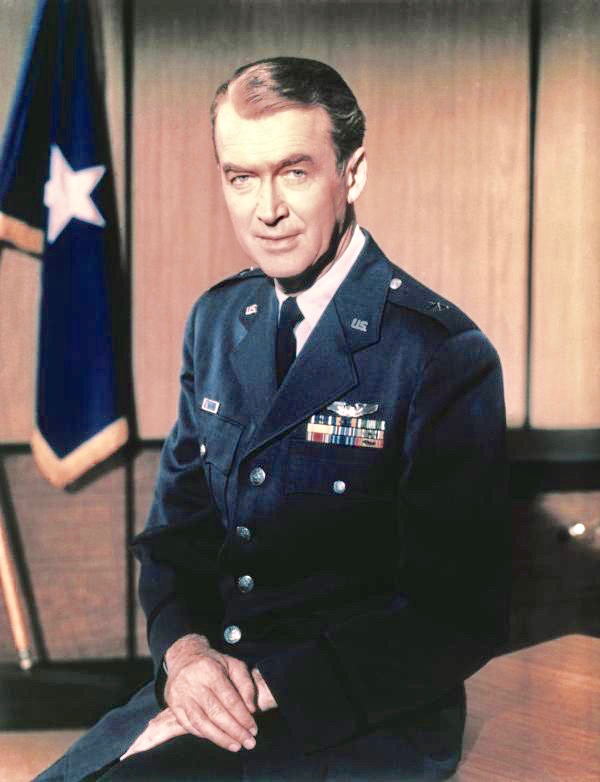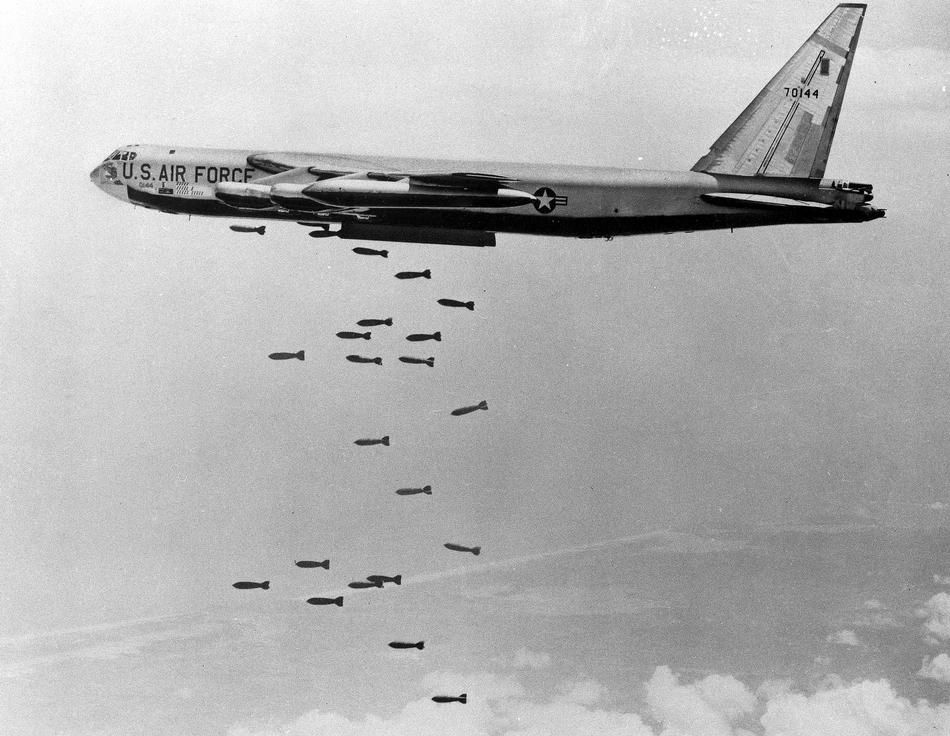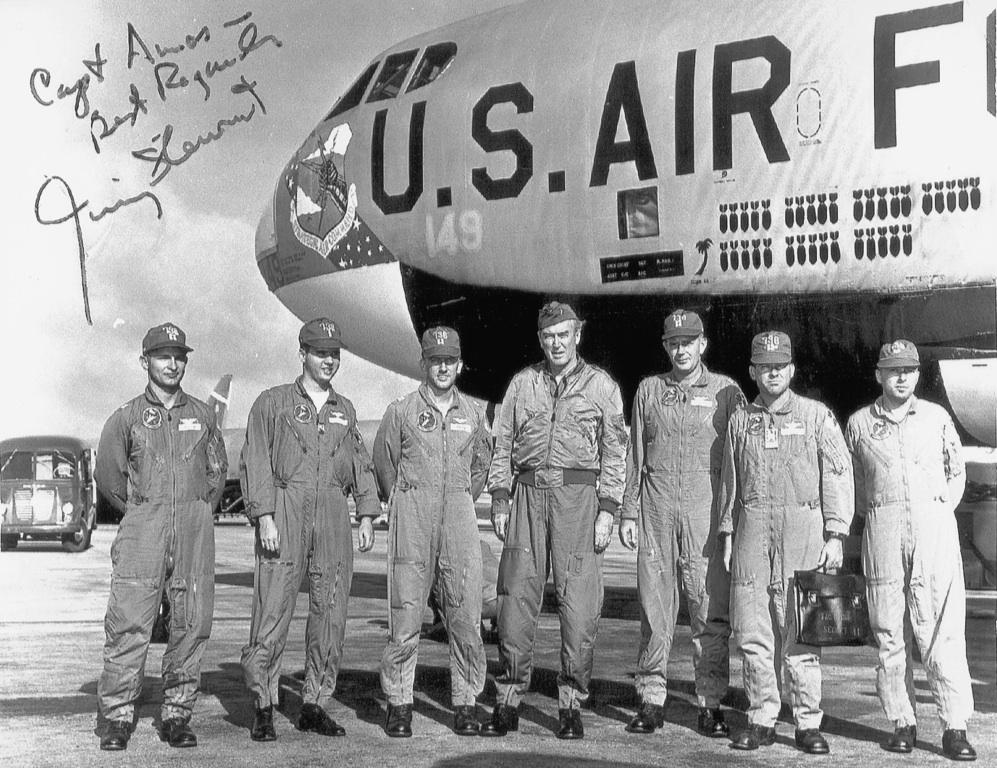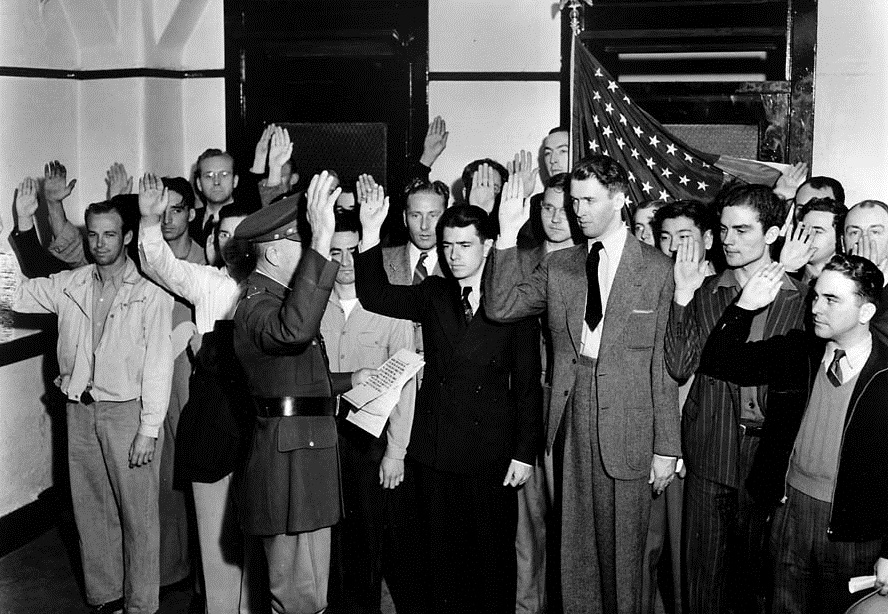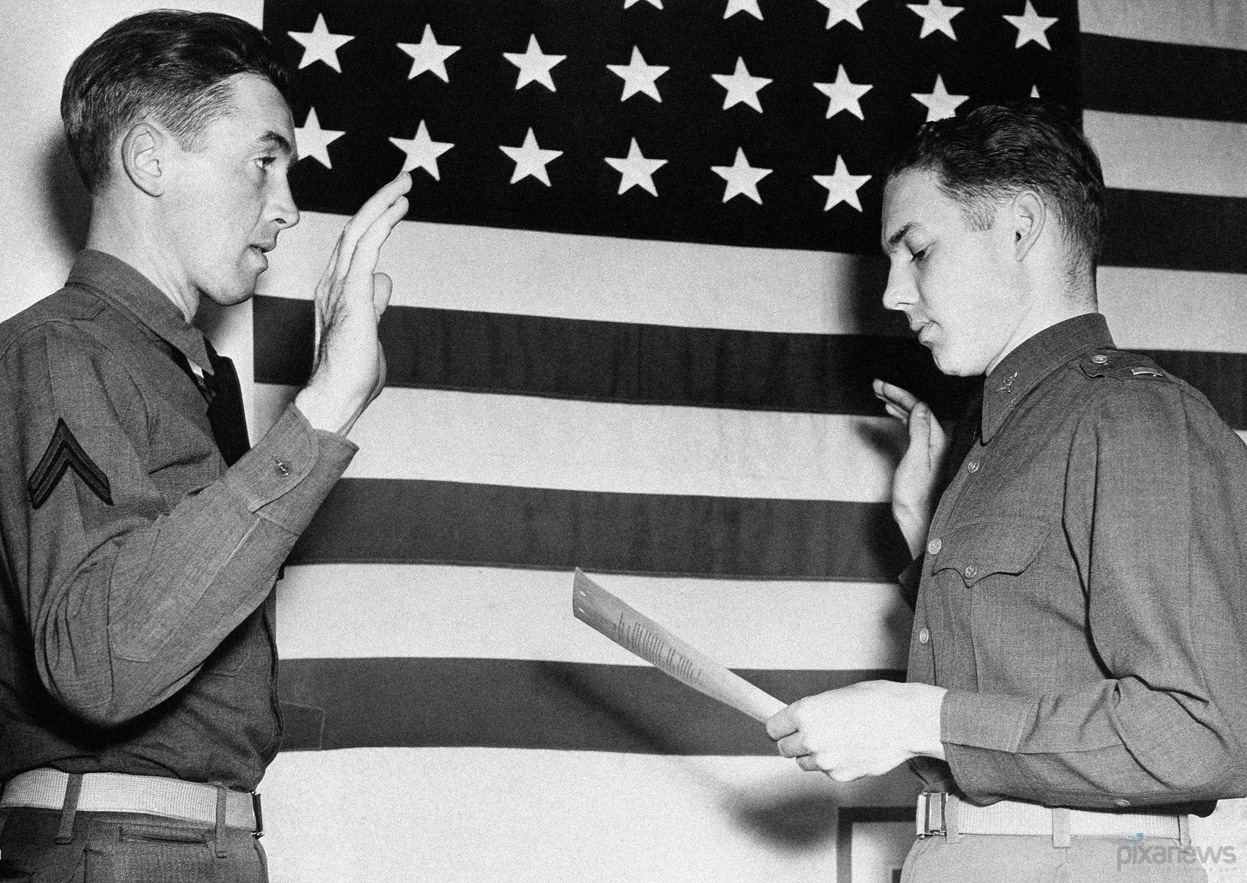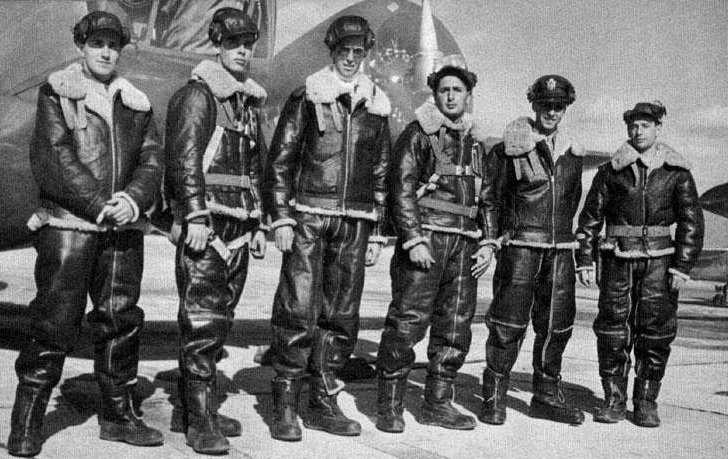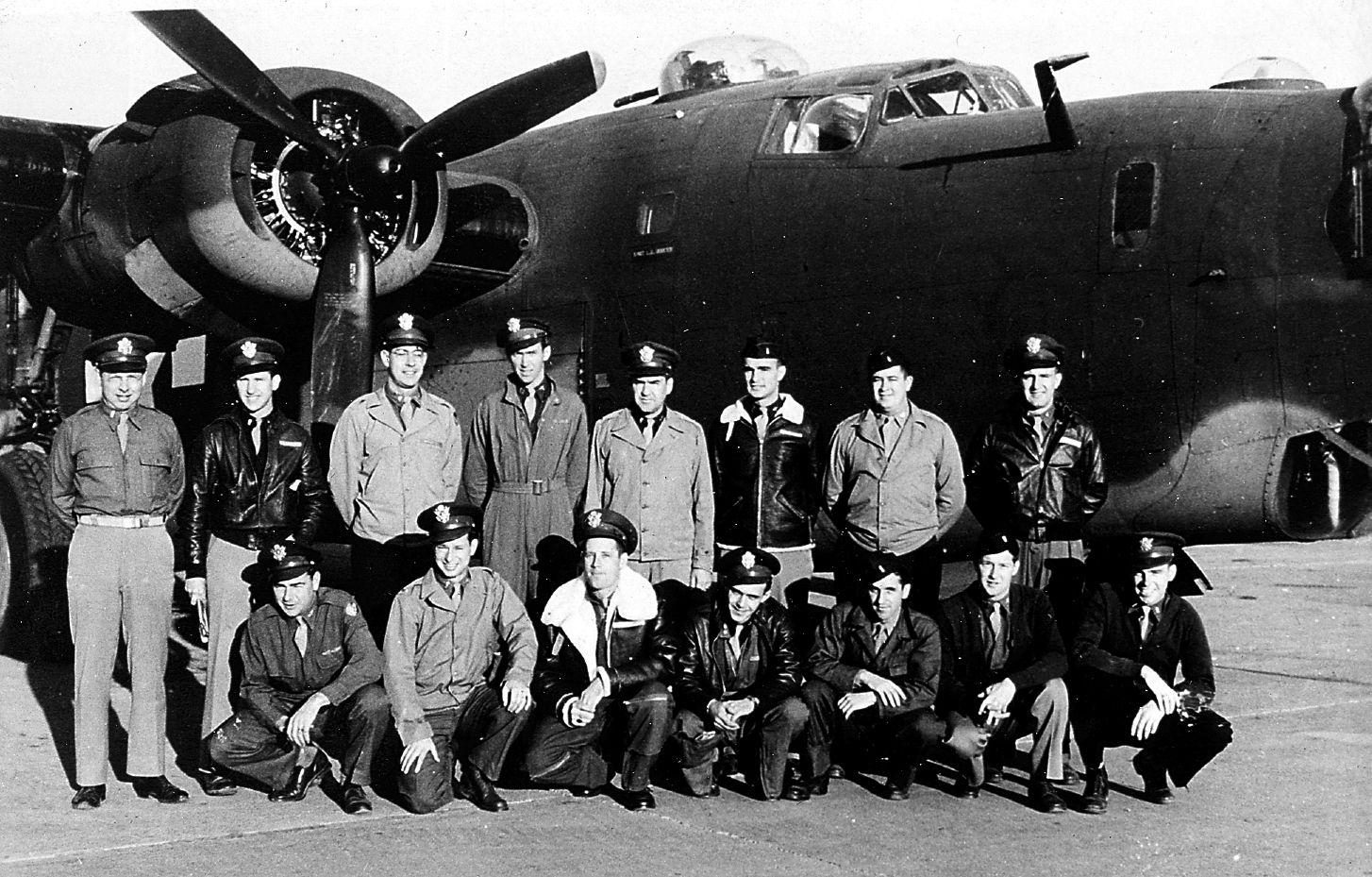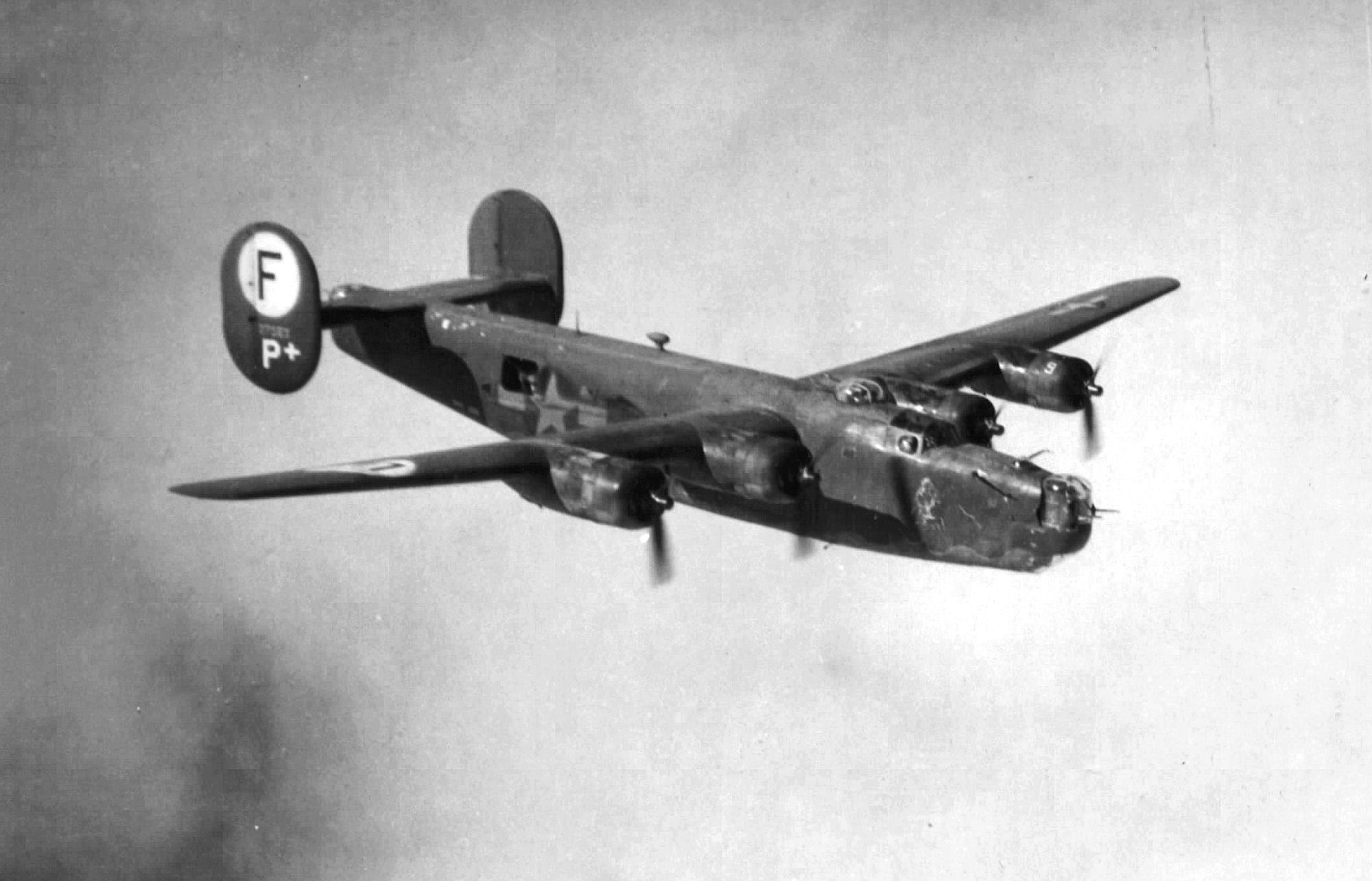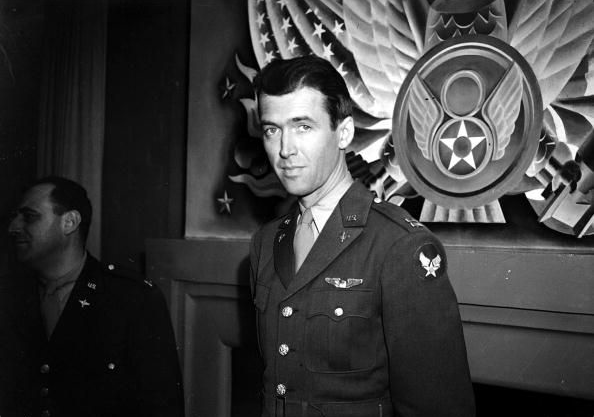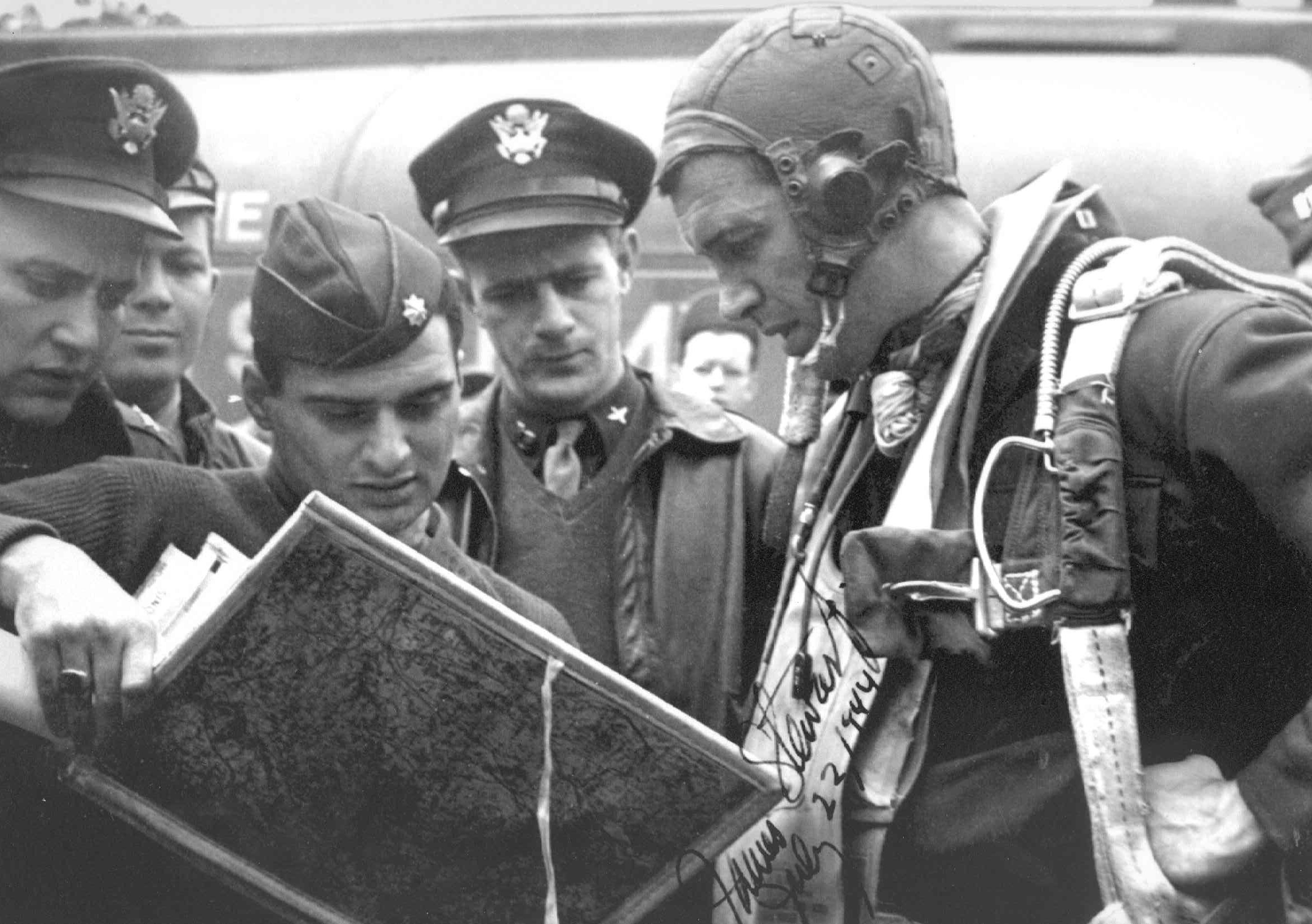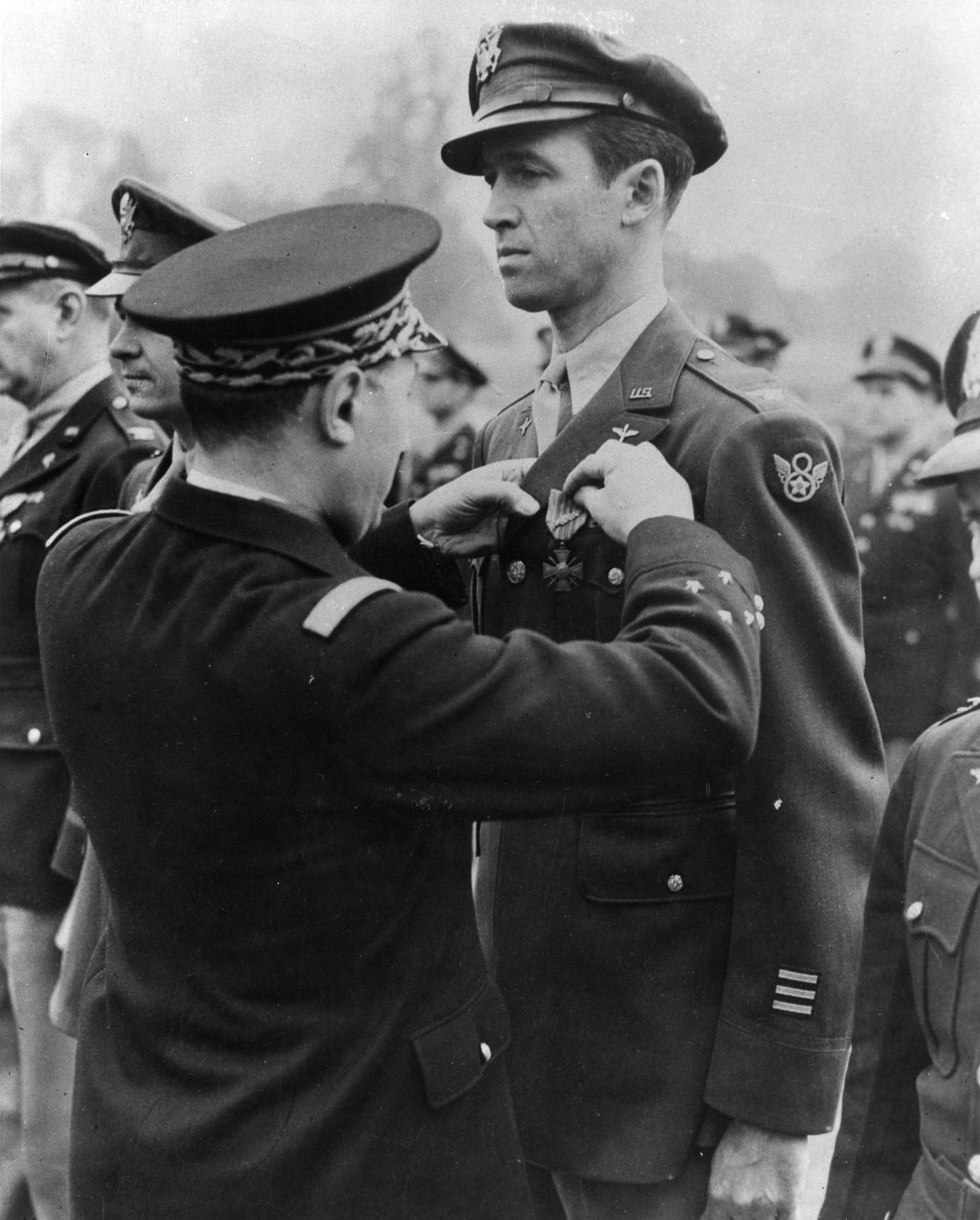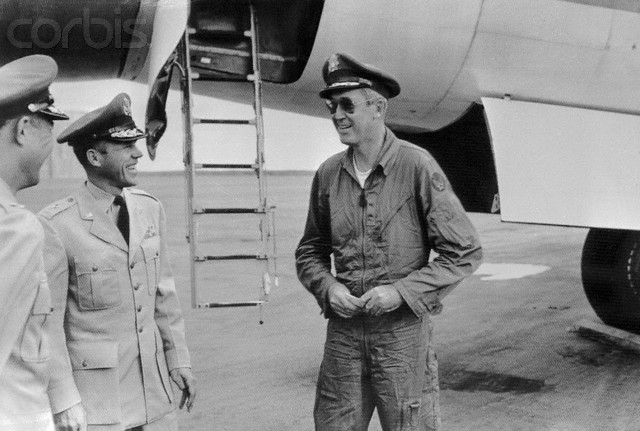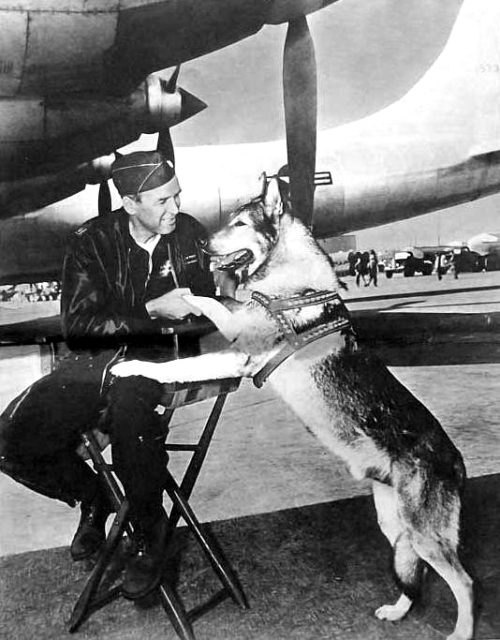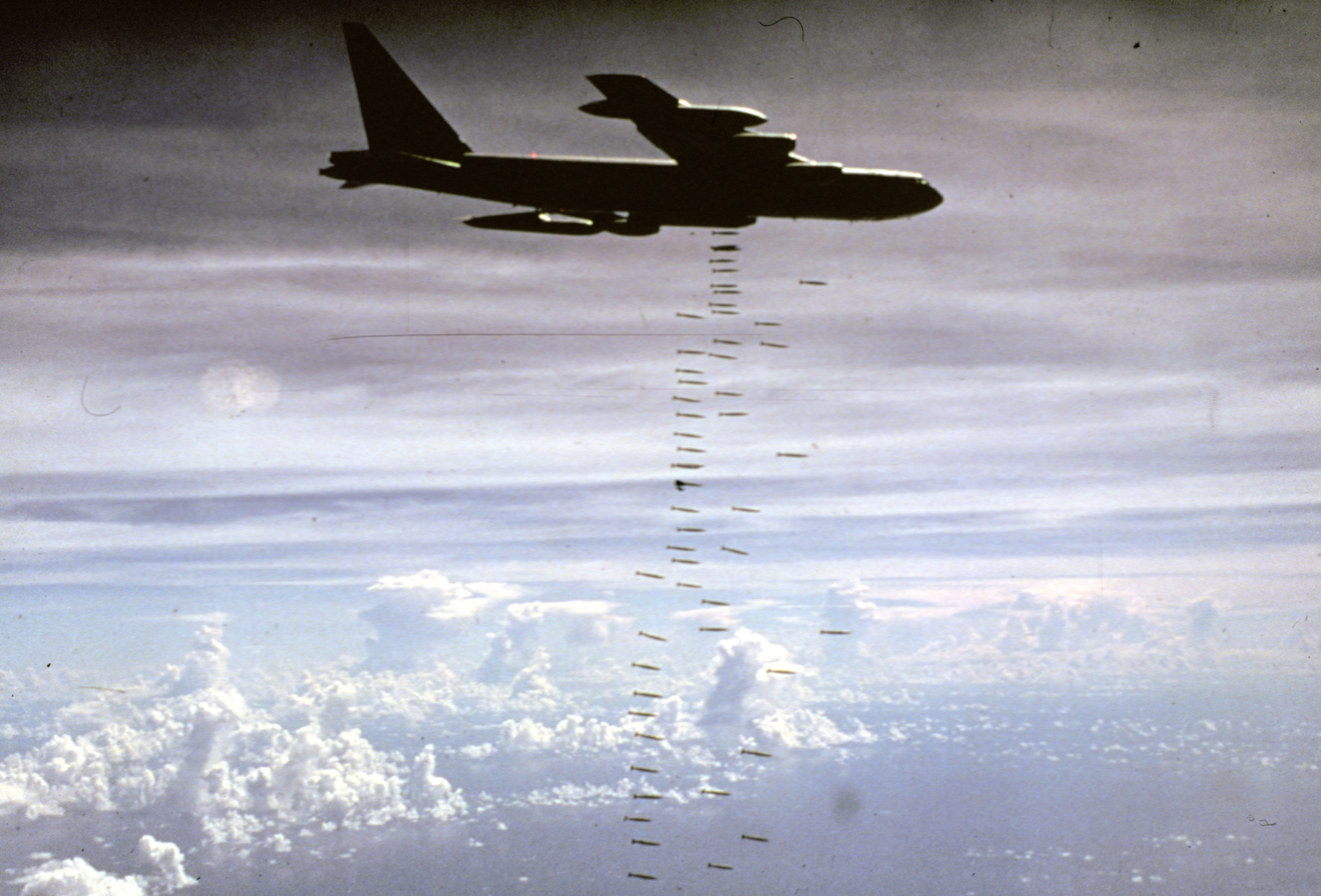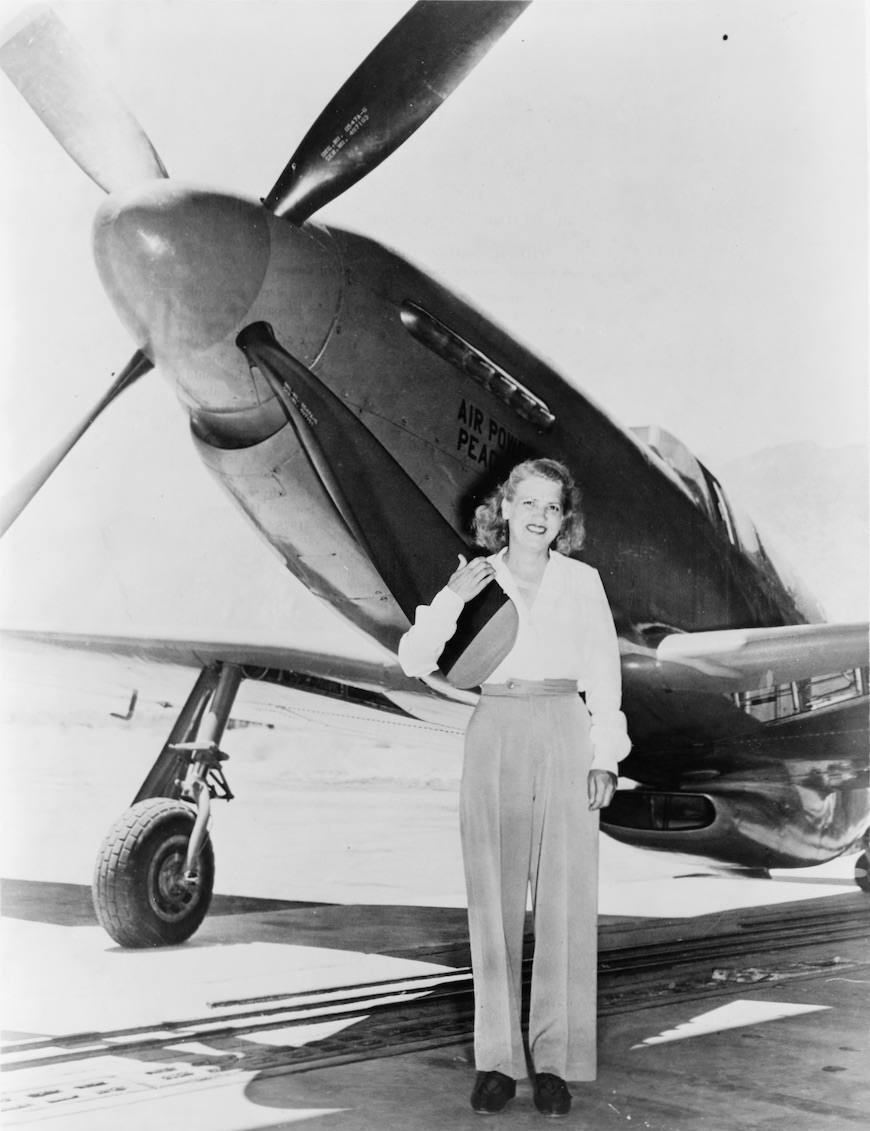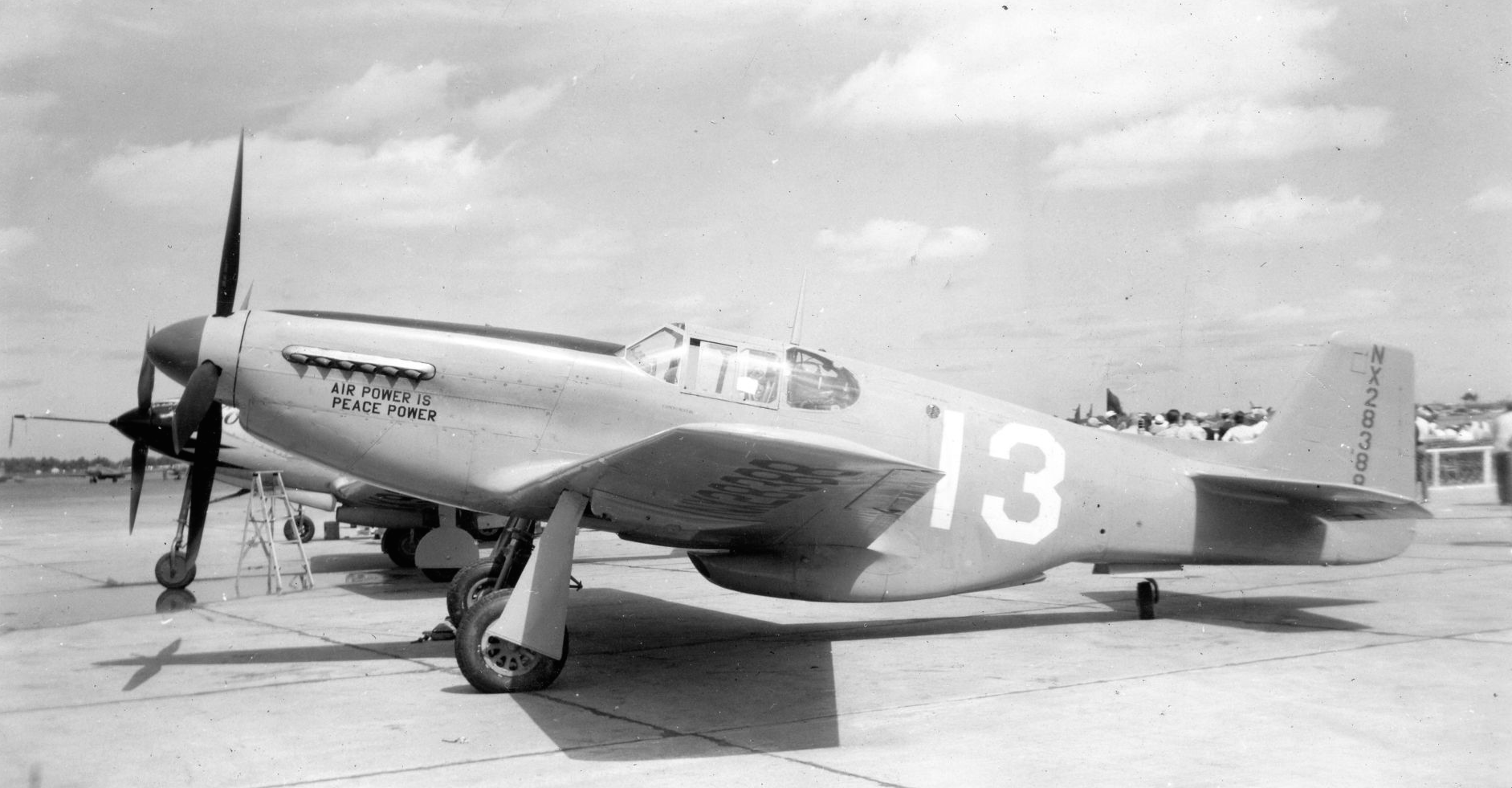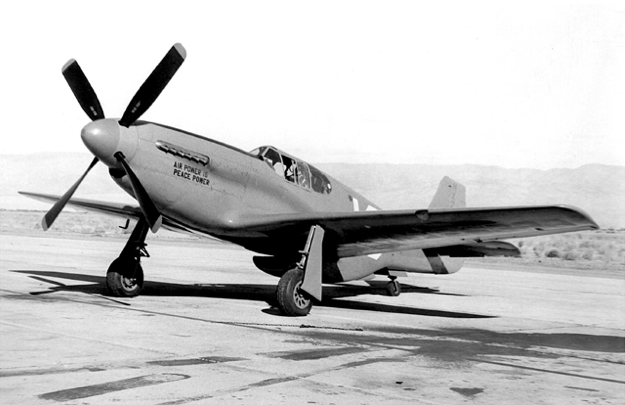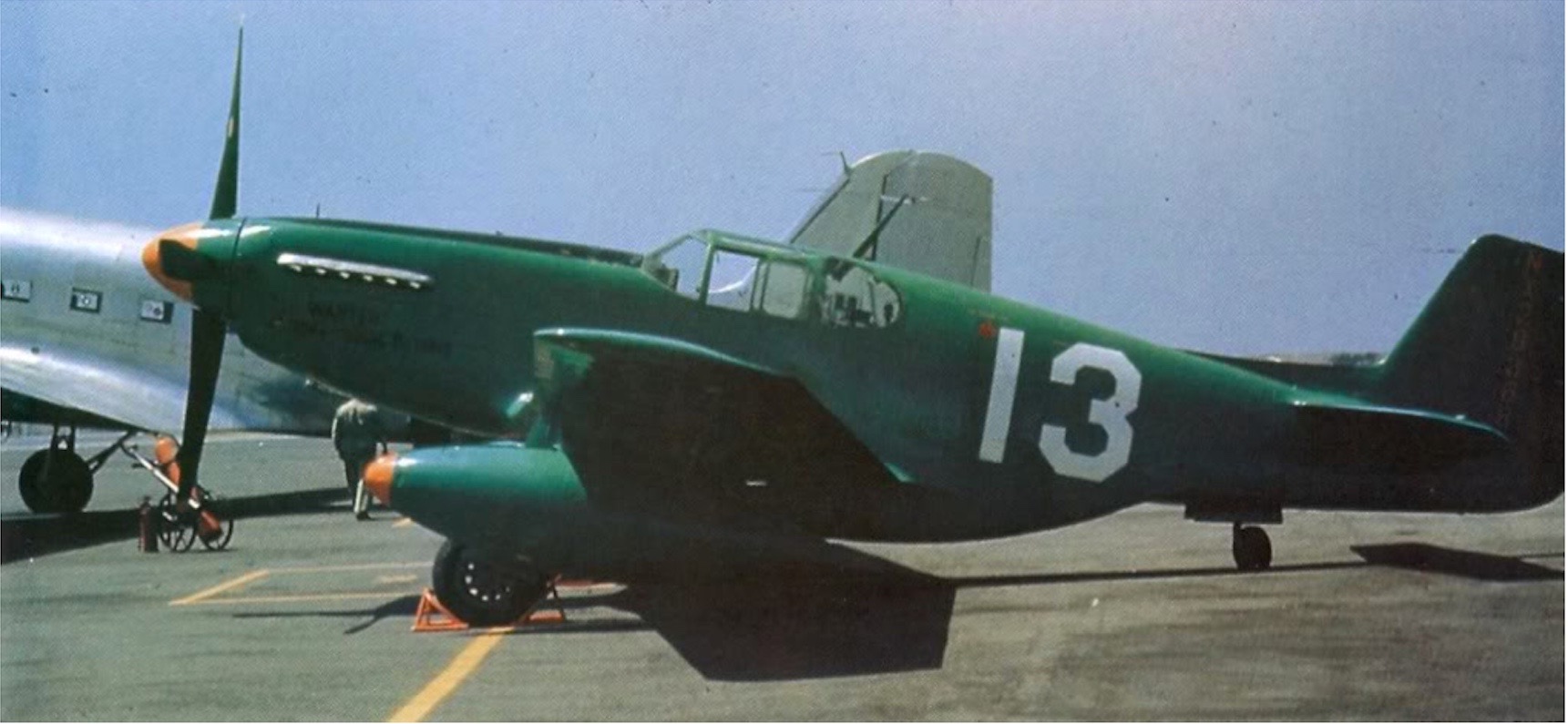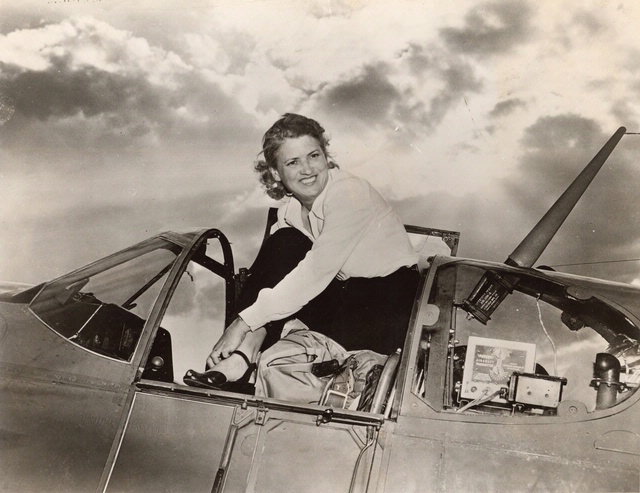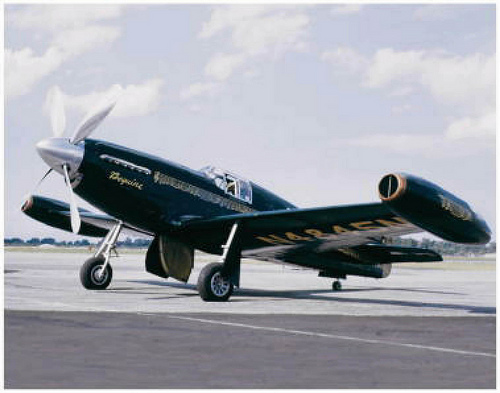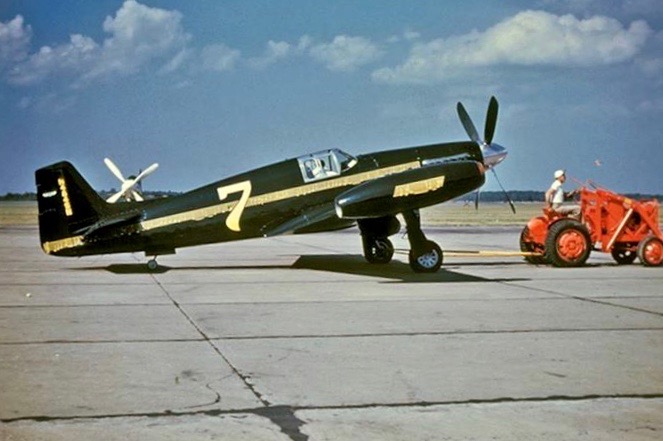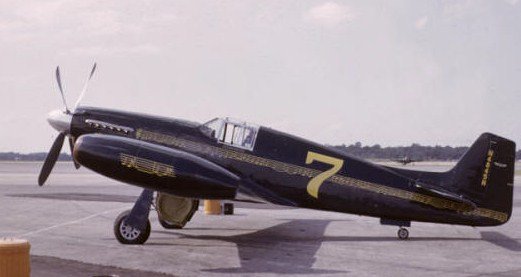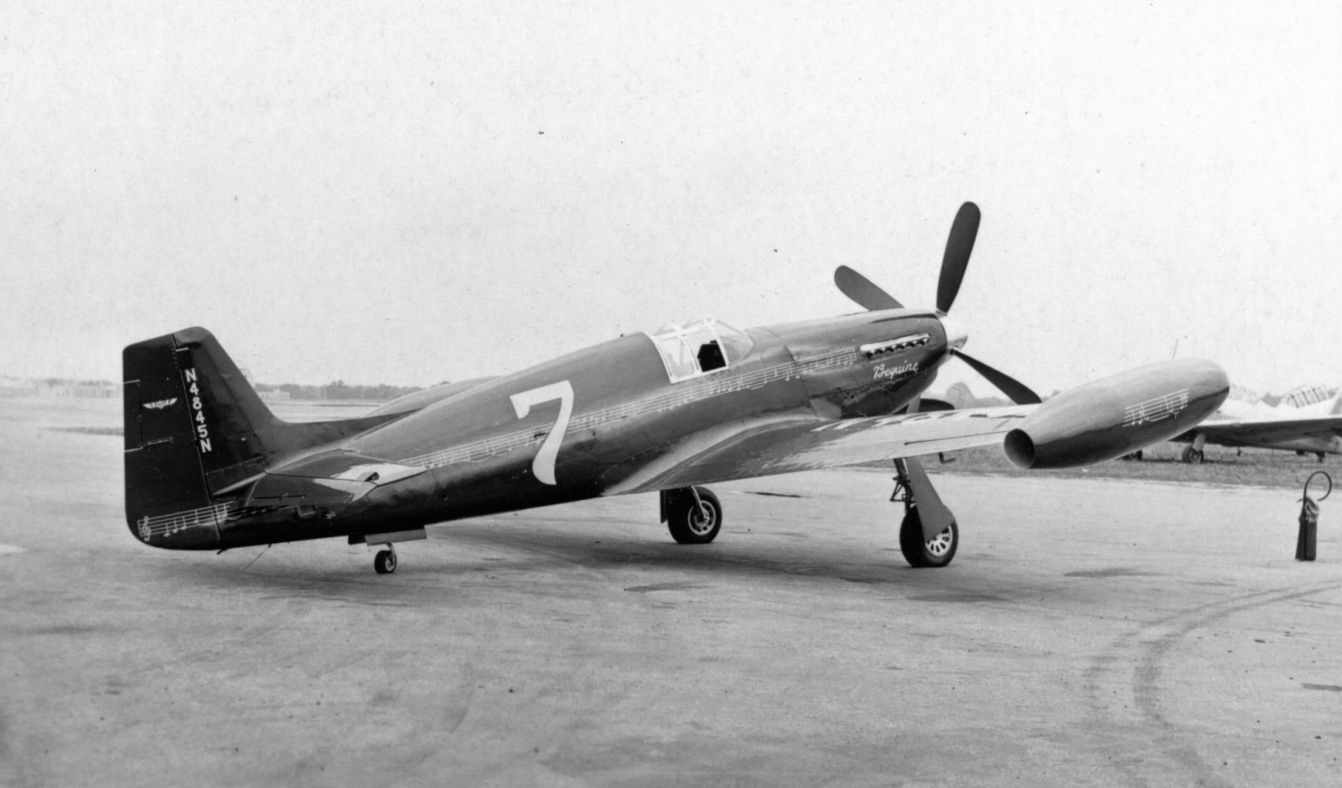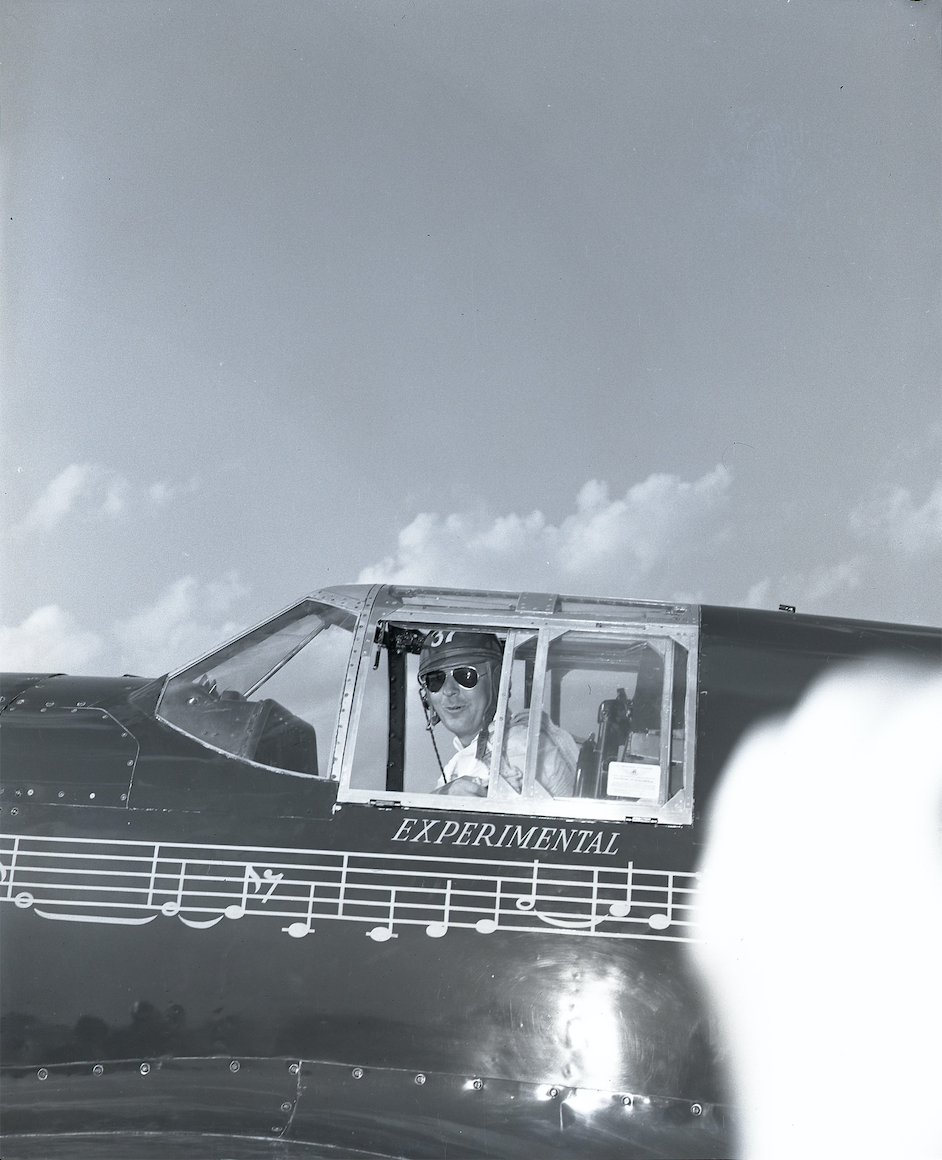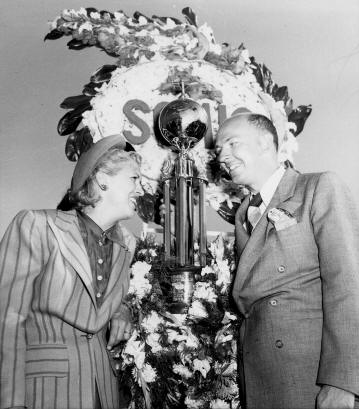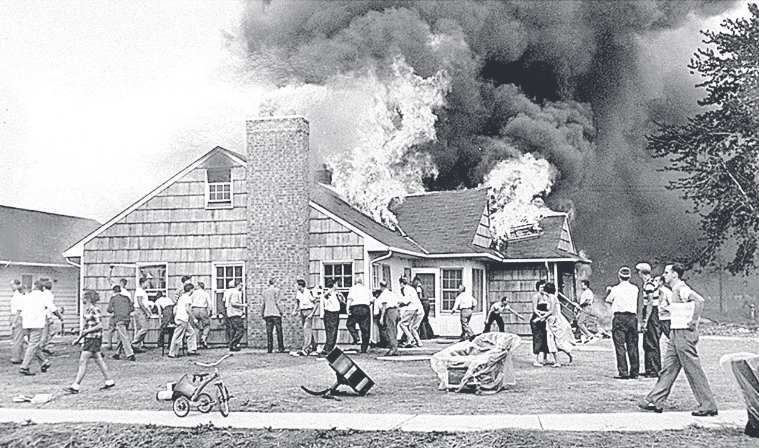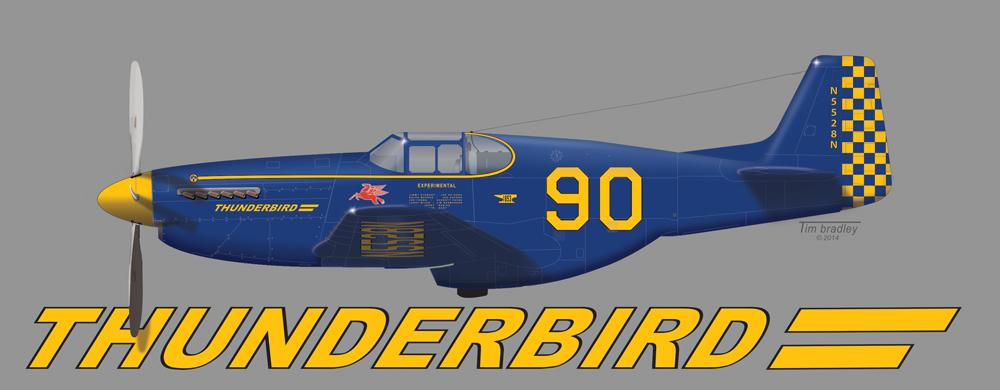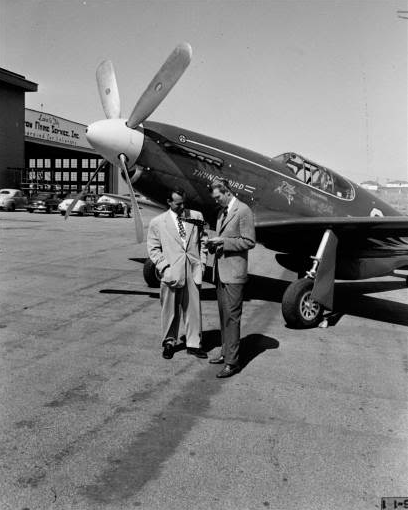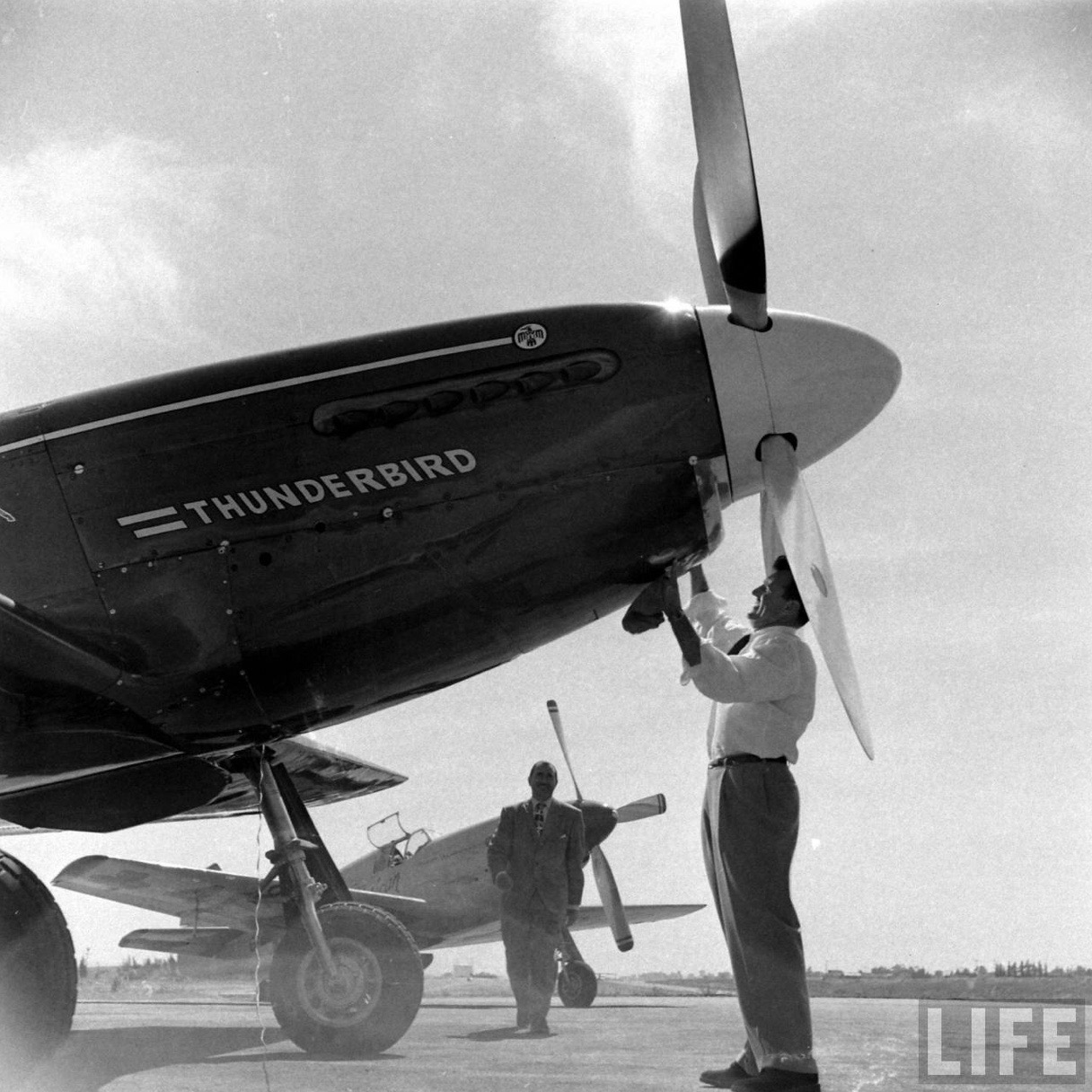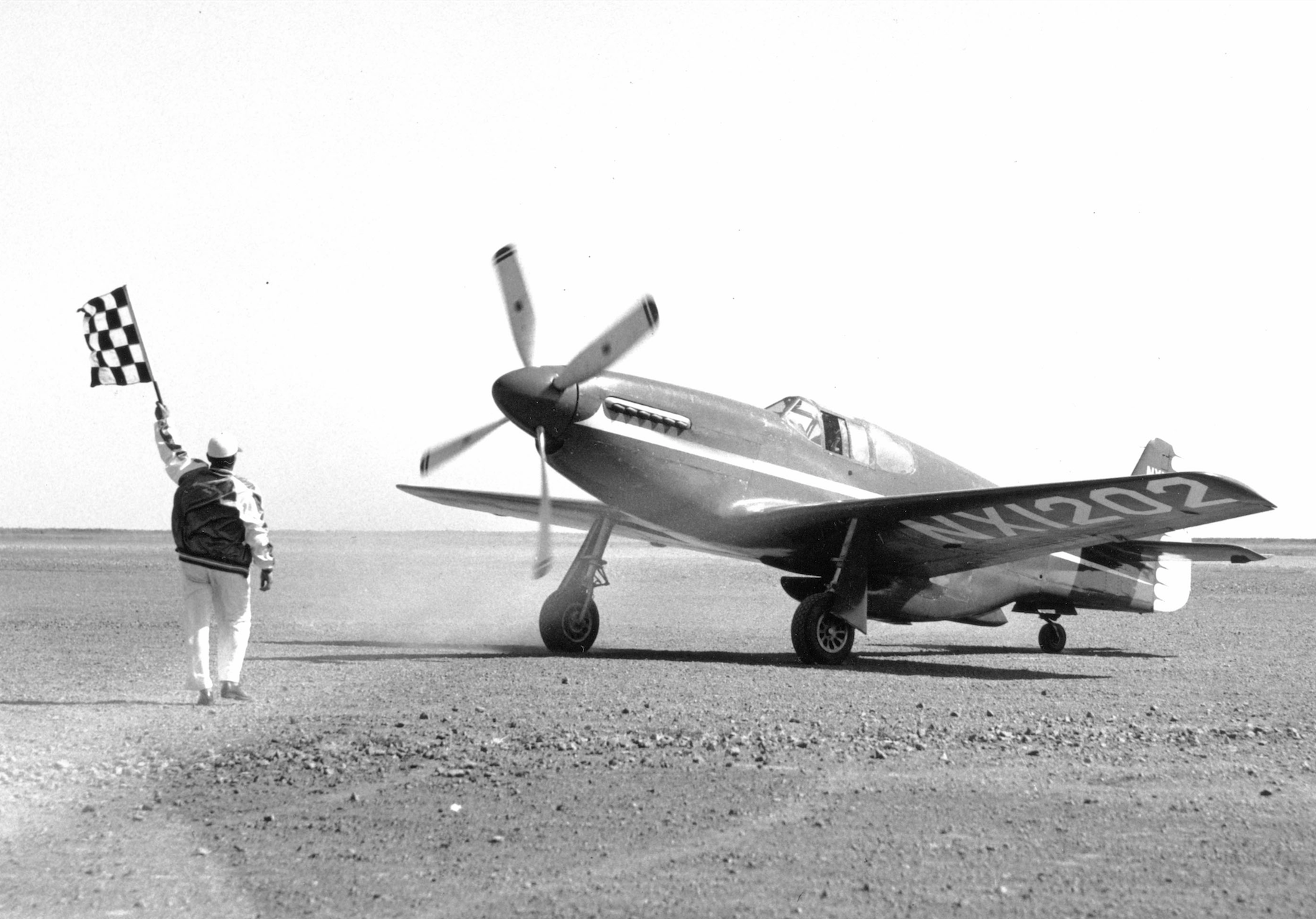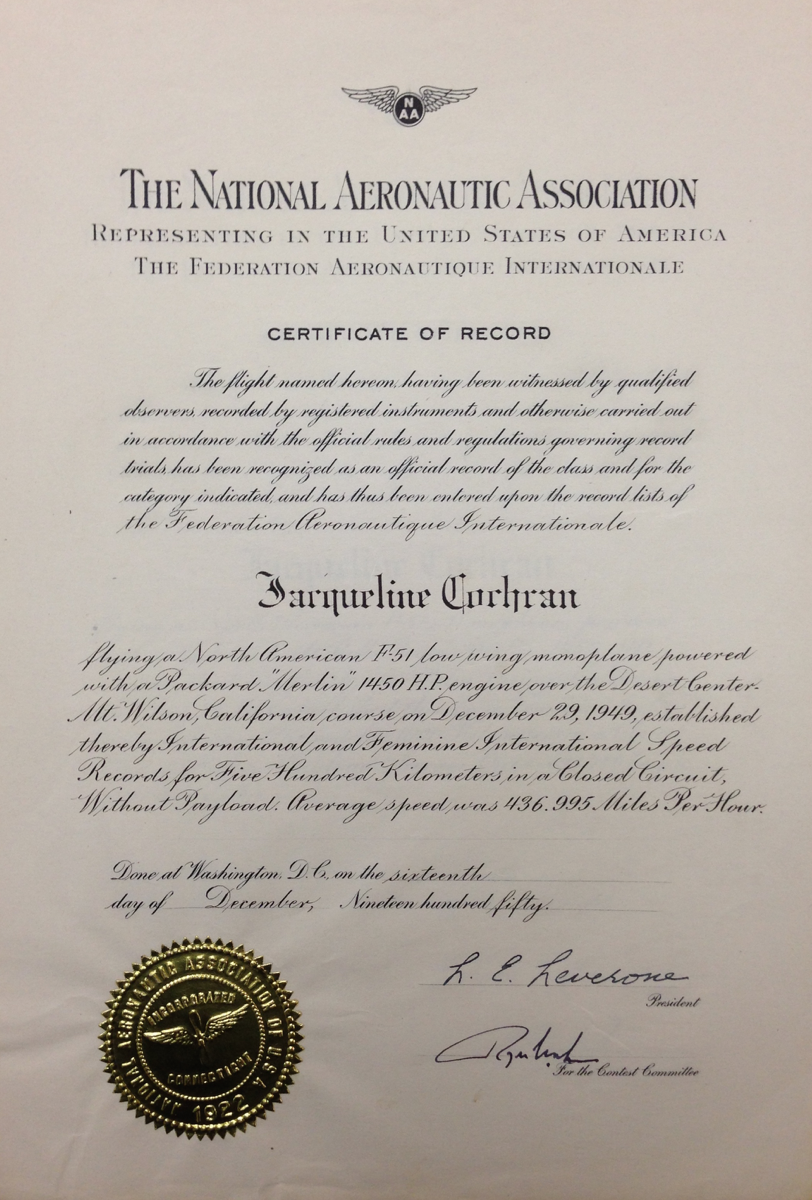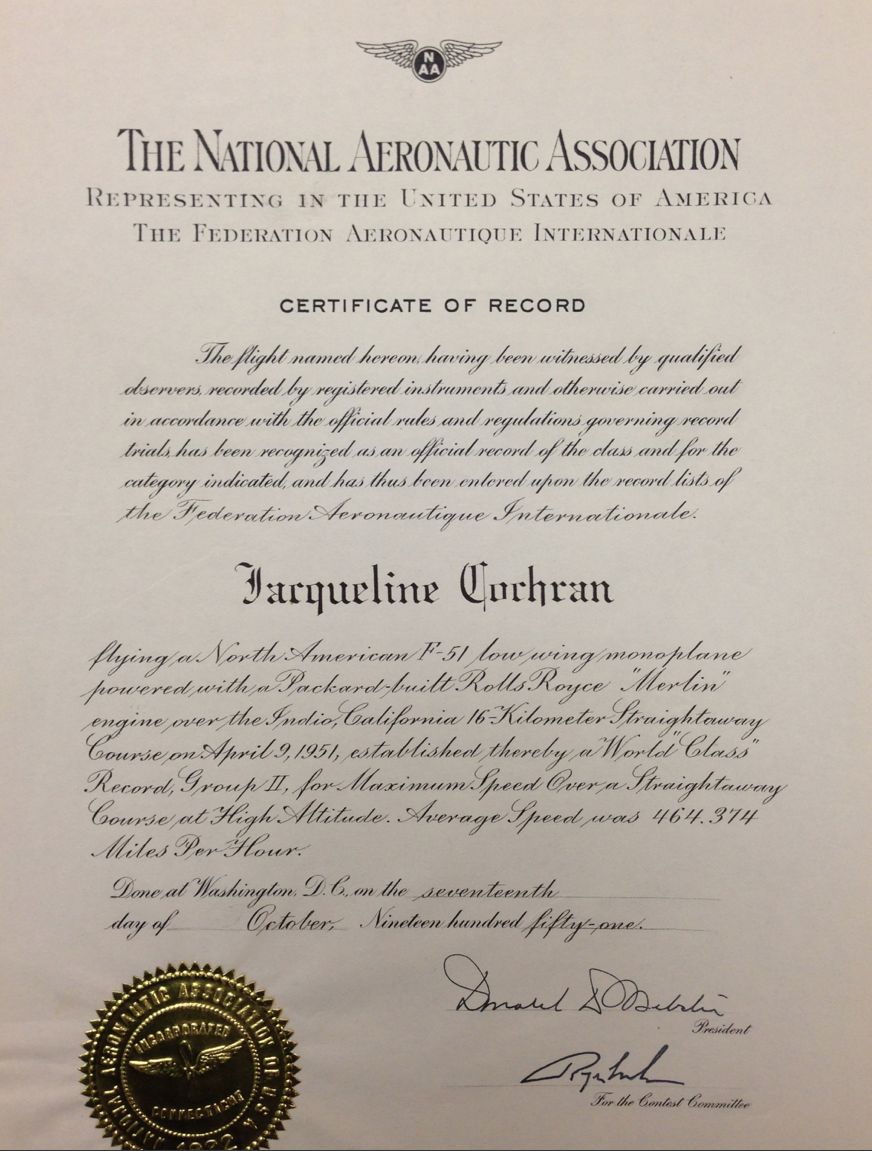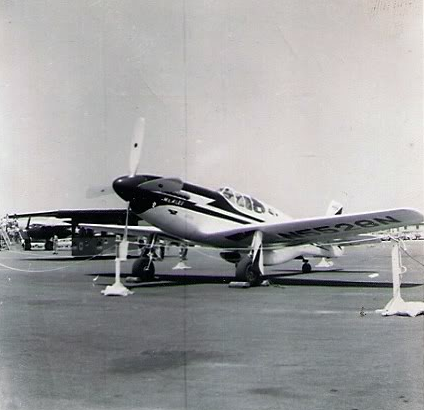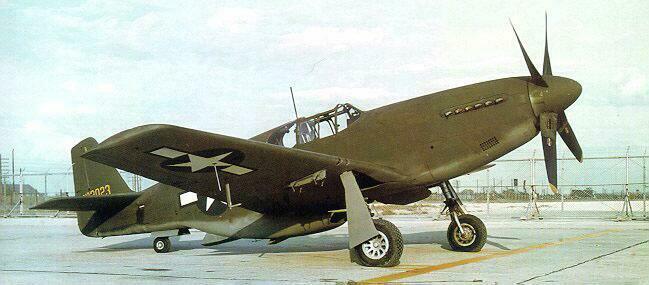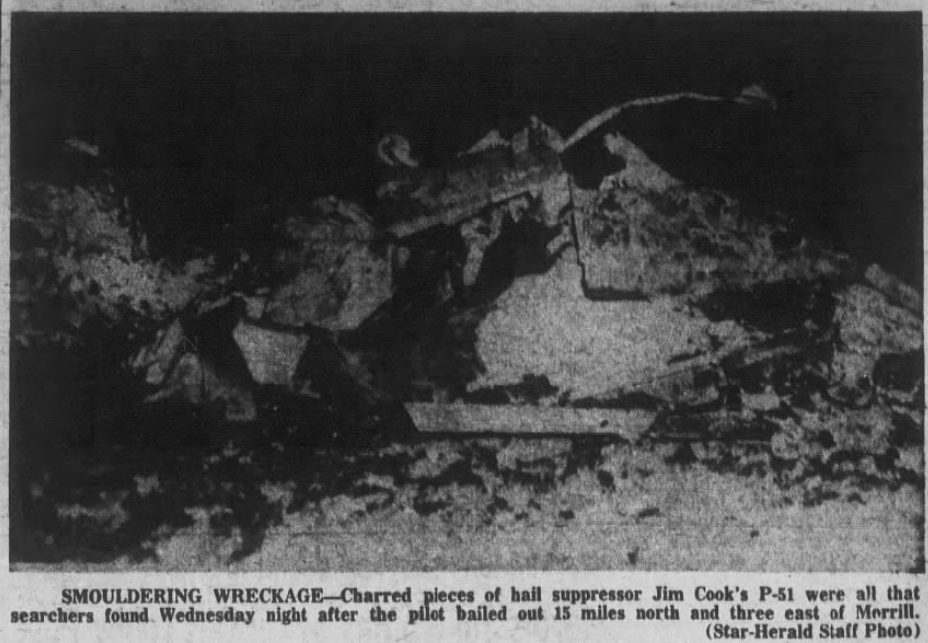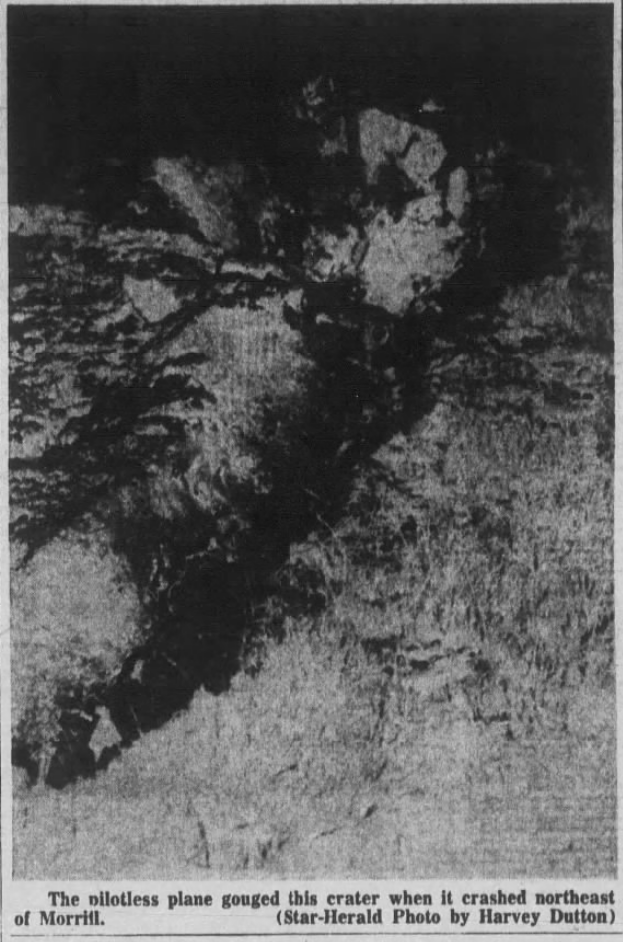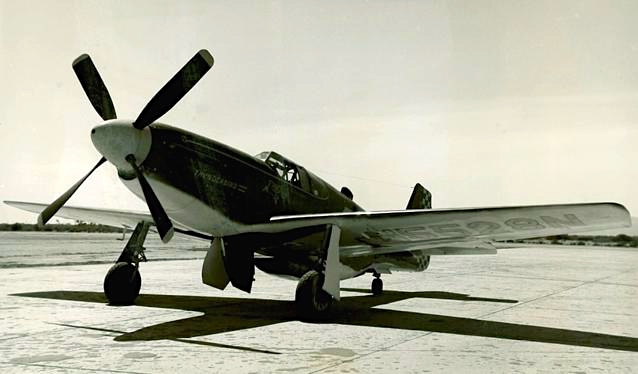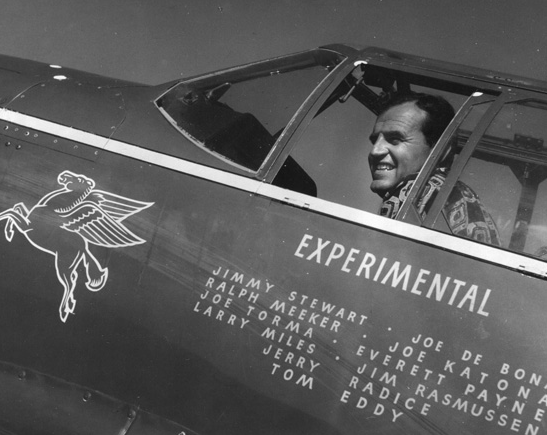
29 March 1949: At 6:20:50 a.m., Pacific Standard Time (13:20:50 UTC), Joseph C. De Bona took off from the Lockheed Air Terminal at Burbank, California, in the cobalt blue North American Aviation P-51C Mustang, N5528N, Thunderbird. He flew across the North American continent to LaGuardia Airport, New York City, arriving at 2:20:55 p.m., Eastern Standard Time (18:20:55 UTC).
De Bona said that he had climbed to 30,000 feet (9,144 meters) in just 17 minutes. He encountered bad weather at Needles, a small city on the west bank of the Colorado River, the boundary between the states of California and Arizona, which continued to St. Joseph, Missouri. The Mustang’s Packard-built V-1650-7 Merlin engine began losing oil over Akron, Ohio, with the oil pressure dropping from the normal 70 pounds per square inch (483 kilopascals) to 20 p.s.i. (138 kPa), and De Bona ran out of oxygen near Sunbury, on the east bank of the Susquehanna River in Pennsylvania.
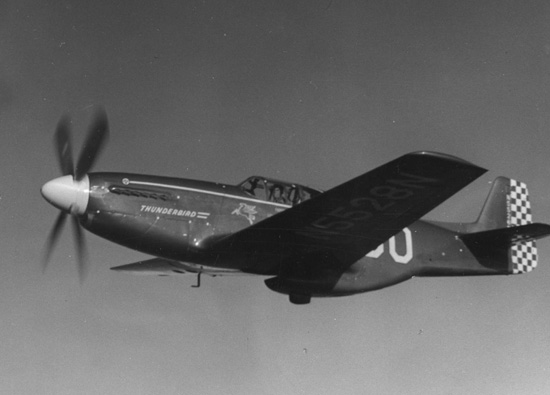
The flight was timed by Fred H. Wilkerson, an official of the National Aeronautic Association. The official distance flown was 2,453.805 statute miles (3,949.016 kilometers). De Bona’s elapsed time for this flight was 5 hours, 5 seconds. His average speed was 490.625 miles per hour (789.584 kilometers per hour). This flight established a new United States national record.
During this flight, no barograph was carried. In the NAA’s official record, Mr. Wilkerson wrote, “I also inspected seals on gas tanks in both wing tips and the fuselage and found all of them broken. These were just plain light plastic seals and it is possible that due to the high speed for several hours, the wind or the vibration could have broken them.”
This was De Bona’s third attempt to break the previous record set by Albert Paul Mantz, 28 February 1947, in his own P-51 Mustang, Blaze of Noon.
The Winona Republican-Herald reported:
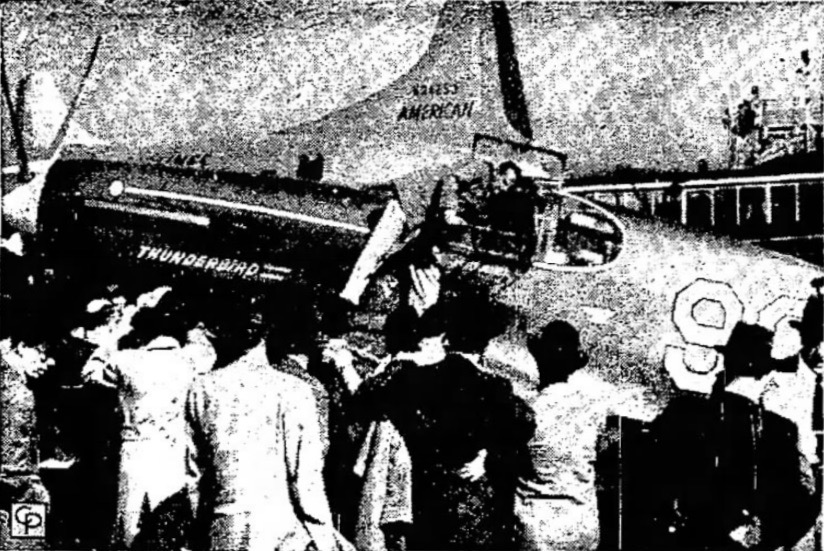
De Bona Flies Across U.S. In Five Hours
New York—Former Army Major Joe De Bona claimed a new transcontinental air record Tuesday of four hours and 57 minutes.
He flew from Burbank, Calif., to New York City in Actor Jimmy Stewart’s F-51 fighter plane.
His plane had a cracked cockpit canopy, dangerously low oil pressure, no oxygen and gasoline for only seven more minutes of flying.
“The canopy cracked when I was zooming in here at 600 miles an hour,” De Bona said. “It scare hell out of me.”
“I’ll never try a record flight again. This was too nerve wracking.”
The cross-country dash began at 9:23 a.m. The stripped-down fighter zoomed over the control tower at New York City’s La Guardia field at 2:20 p.m.
New Record
The present record for the distance is six hours, seven minutes and five seconds. It was set by Paul Mantz, Hollywood stunt pilot, in February, 1947.
De Bona had little trouble and said he averaged 530 miles an hour, pushed along by a 55-mile-an-hour tail wind.
In Los Angeles Stewart, a wartime bomber pilot, quickly claimed a new record and gave De Bona full credit.
“I’m sure proud of him,” said Stewart.
Sanded Finish
Stewart said the plane, which he bought 15 months ago, was not “souped up” but was painted, polished and sanded to get a slick finish.
As he stepped down from the plane at the airport, De Bona said he had started with 850 gallons of gas and had only 30 gallons left.
“Thirsty and a little bit sleepy,” he said he flew at 30,000 feet most of the time but came down to 19,000 feet when his oxygen supply ran low.
—The Winona Republican-Herald, Vol. 49, No. 36, 30 March 1949, Page 14, Column 1
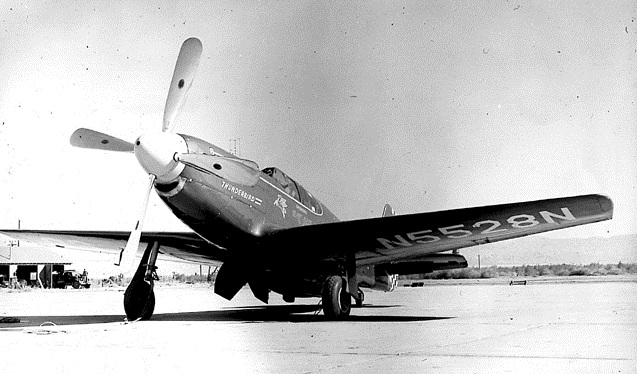
The earliest document in Thunderbird‘s Civil Aviation Administration file, Form ACA 132, contains the hand-written notation, “no service no.” The document states, “THIS AIRCRAFT WAS ASSEMBLED FROM COMPONENTS OF OTHER AIRCRAFT OF THE SAME TYPE.” The aircraft is designated on the form as a North American P-51C, Serial No. 2925.
Thunderbird, made up of salvaged parts, has no known Army Air Corps serial number. No North American Aviation contract number is listed in any document. It has no known history prior to the C.A.A. assigning it the civil registration NX5528N. The serial number 2925 does not conform to any U.S. Army Air Corps serial number sequence for P-51 series aircraft, nor does it conform to any N.A.A. contract number sequence for P-51s. It appears that this serial number was assigned to the P-51 by the Civil Aeronautics Administration.
Various sources attribute U.S.A.A.C. serial numbers to NX5528N, e.g., “43-6822” and “43-6859.” There is nothing in the airplane’s C.A.A. records to substantiate these claims. The record specifically states that there is “no service no.” Some sources also describe Thunderbird as a P-51B or an F-6C photo reconnaissance variant. C.A.A. records specifically identify the airplane as a P-51C.
Thunderbird‘s fuselage was purchased as “salvage & scrap” from the 803rd A.A.F. Specialized Depot, Park Ridge, Illinois, by Allied Aircraft Co., Chicago, Illinois. The transaction is dated 14 January 194_ (the year was left blank on the contract). The purchase price was $27.05. Allied Aircraft Co. was a partnership of Leland H. Cameron and Martha L. Cameron, 5300 W. 63rd Street, Chicago, Illinois.
On 11 February 1948, Cameron purchased a P-51, Serial No. 2925, registration N5528N, from J. Quaine, for $1.00. On 5 April 1948, the Civil Aeronautics Authority (predecessor to the Federal Aviation Administration) registered N5528N to L.H. Cameron, 4619 Sancola Avenue, North Hollywood, California.
Two days later, 7 April 1948, Leland Cameron sold N5528N to Joe De Bona Racing Co., 133 N. Robertson Boulevard, Beverly Hills, California. The purchase price listed on the Department of Commerce Bill of Sale was $10.00. On that date, Joe De Bona applied to have the airplane registered in the name of his racing company.
Interestingly, on De Bona’s Department of Commerce Application for Registration, the serial number of N5528N is listed as “21925.” Information on the application is typewritten with the exception of this serial number, which was handwritten. As above, 21925 does not conform to any Army Air Corps or North American Aviation serial number for P-51B or P-51C Mustangs. This is the only instance in which 21925 appears in the airplane’s C.A.A. records.
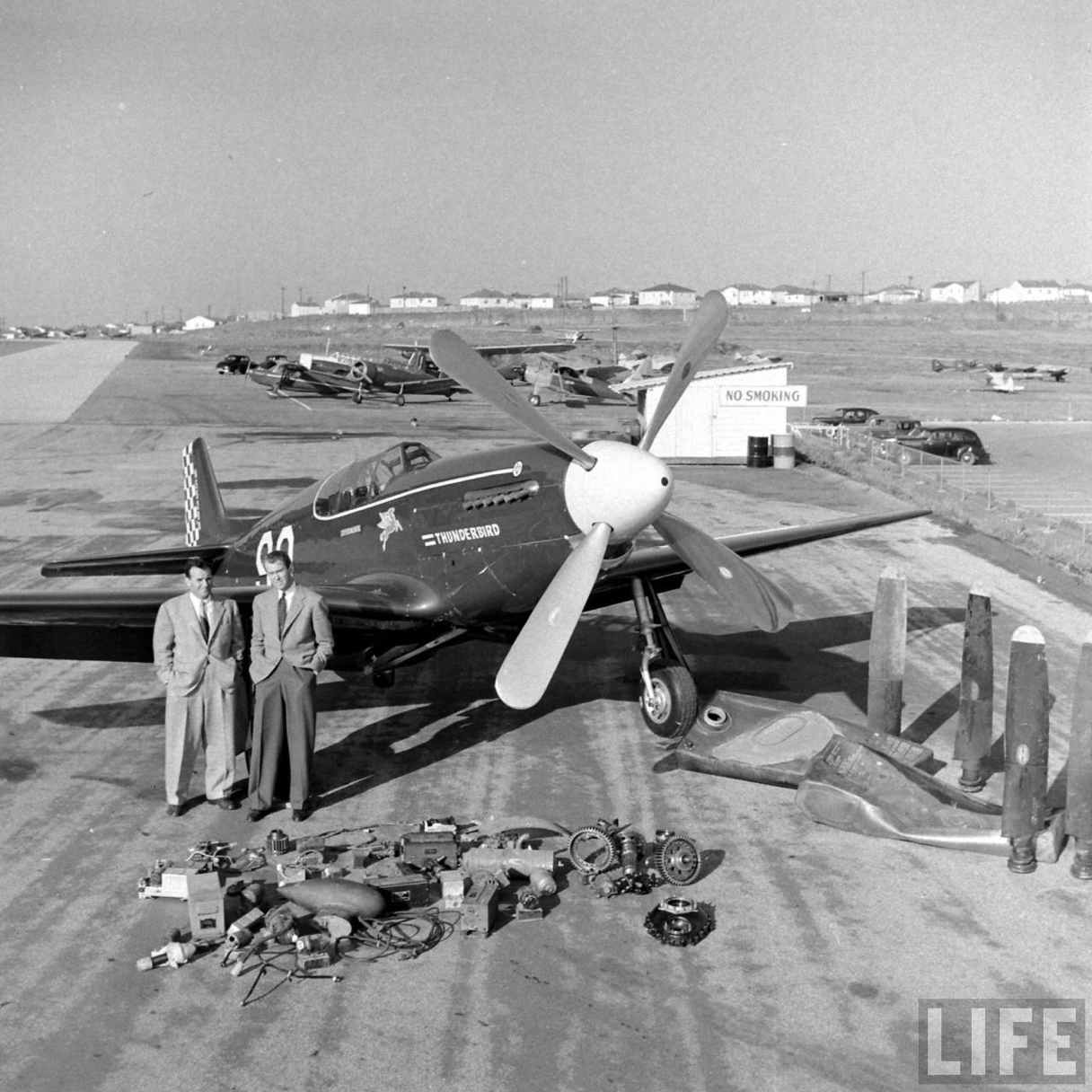
The Civil Aeronautics Administration registered N5528N to Joe De Bona Racing Co., 15 April 1948. Joe C. De Bona was an experienced air racer. The company was a partnership between De Bona and James M. (Jimmy) Stewart.
Over the next several months, N5528N, now named Thunderbird, was prepared for the upcoming 1948 Bendix Trophy Race. Unnecessary equipment such as the self-sealing fuel cells, the fuselage fuel tank, etc., were removed to save weight. The airframe seams were filled with putty and sanded smooth. Many coats of primer were applied followed by the the high-gloss “cobalt blue” paint. Gold decorative trim was applied. Thunderbird‘s airworthiness category, EXPERIMENTAL, was painted under the canopy rail on each side. Sponsors’ logos and crew member’s names were painted on the left side of the fuselage beneath the canopy. (The significance of the anvil logo with the numbers “1853” is not known.) The rudder was painted in a checkerboard pattern and the race number 90 applied to both sides of the fuselage. The registration was painted vertically on the fin, the top of the right wing and the bottom of the left wing.
On 31 August 1948, following an airworthiness inspection, C.A.A. Inspector Homer L. Stamets issued an original Airworthiness Certificate to NX5528N. The “Experimental” classification was used as there was no civil Type Certificate for North American’s P-51 fighters, and the C.A.A. had not tested or accepted the aircraft for any civilian use. The Experimental classification placed severe restrictions on De Bona’s use of Thunderbird. In the Operations Authorized section of the certificate it states, “Certificated for the purpose of Racing and Exhibition flights only; flights limited to the Continental limits of the UNITED STATES. Flights prohibited over thickly populated areas or large gatherings of people.” The certificate was valid for one year.
Noted on the Airworthiness Inspection form is that NX5528N was equipped with a Packard V-1650-3 engine. This license-built version of the Rolls-Royce Merlin 63 engine was standard equipment for early production P-51B and P-51C Mustangs. It was rated at 1,380 horsepower at 3,000 r.p.m. and 60 inches of manifold pressure.
The start of the 1948 Bendix Trophy Race took place on 4 September at Van Nuys, California. Joe De Bona was entered with Thunderbird, but was unable to complete the race. Reportedly low on fuel, he landed at Norwalk, Ohio. (As noted above, Jackie Cochran placed 3rd in this race flying NX28388.)
For 1949 Thunderbird‘s engine was upgraded to a Packard V-1650-7. C.A.A. Inspector Stamets again approved its airworthiness inspection and issued another one-year Experimental certificate with same restrictions as previously.
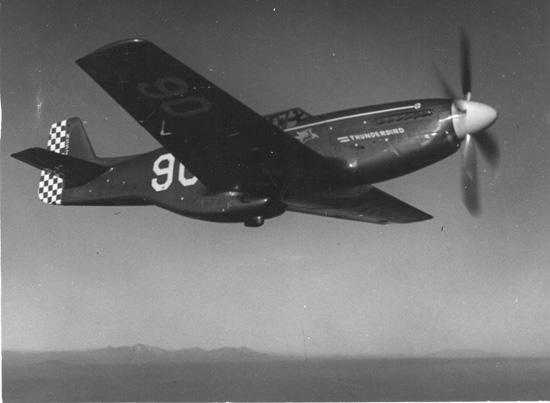
On 29 March 1949, Thunderbird, established a new U.S. national speed record of 490.625 miles per hour (789.584 kilometers per hour).
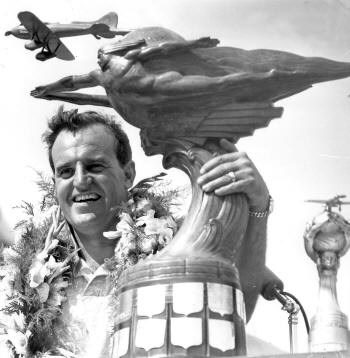
The start of the 1949 Bendix Trophy Race was relocated from Metropolitan Airport at Van Nuys to Rosamond Dry Lake, 40 miles (64.4 kilometers) north of Muroc Air Force Base (renamed Edwards AFB just two months later). This year, Joe De Bona was successful. He won the 2,008 mile (3,231.6 kilometers) race to Cleveland, Ohio in an elapsed time of 4:16:17.5, averaging 470.136 miles per hour (756.611 kilometers per hour.) Paul Mantz did not fly in the race but entered two P-51Cs, flown by Stanley H. Reaver and Herman “Fish” Salmon, who placed 2nd and 3rd.
(Leland Cameron, who had sold N5528N to Joe De Bona Racing, also competed in the 1949 Bendix air race. He flew a Martin B-26C-20-MO Marauder medium bomber, serial number 41-35071, N5546N, but he did not finish within the prescribed time limit.)
On 19 December 1949, James Stewart (Sole Owner, for Joe De Bona Racing Co.) sold N5528N to Jacqueline Cochran of Indio, California, for “$1.00 and other consideration.” The C.A.A. issued a new Certificate of Registration to Jackie on 29 December 1949.
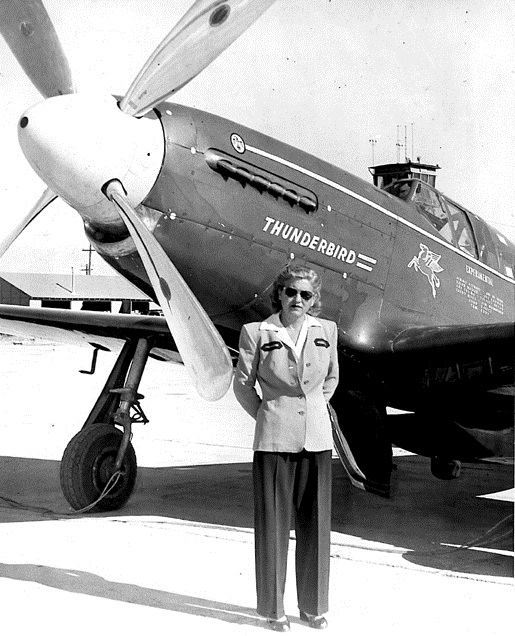
That same day, Jackie Cochran flew her new airplane to two Fédération Aéronautique Internationale (FAI) World Records for Speed Over a 500 kilometer Closed Circuit Without Payload, and a U.S. National Aeronautic Association record, with an average speed of 703.275 kilometers per hour (436.995 miles per hour). (FAI Record File Numbers 4476, 12323)
Thunderbird underwent another airworthiness inspection, completed 10 November 1950 by Patrick J. Kavanaugh, A&E 402226. C.A.A. Inspector H.W. Kattleman issued a new Experimental airworthiness certificate, valid from 10 November 1950 to 10 November 1951. The limitations were identical to the restrictions described above.
Jackie set another Fédération Aéronautique Internationale record on 9 April 1951, flying NX5528N to an average speed of 747.338 kilometers per hour (464.374 miles per hour) over a straight 16 kilometer (9.942 miles) course at Indio, California. (FAI Record File Number 4477)
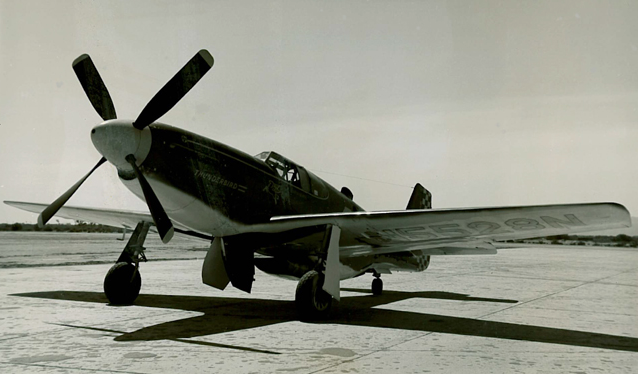
The next airworthiness inspection of N5528N was completed 26 March 1952 by mechanic James N. Smith. Once again, C.A.A. Inspector H.W. Kattleman issued an Experimental airworthiness certificate, valid from 31 March 1952 to 31 March 1953.
Jackie Cochran had owned Thunderbird for just over three years when, on 20 January 1953, she sold it back to Jimmy Stewart for “$1.00 and other consideration.” The C.A.A. registered N5528N to Stewart at 141 El Camino Drive, Beverly Hills, California, 9 April 1953.
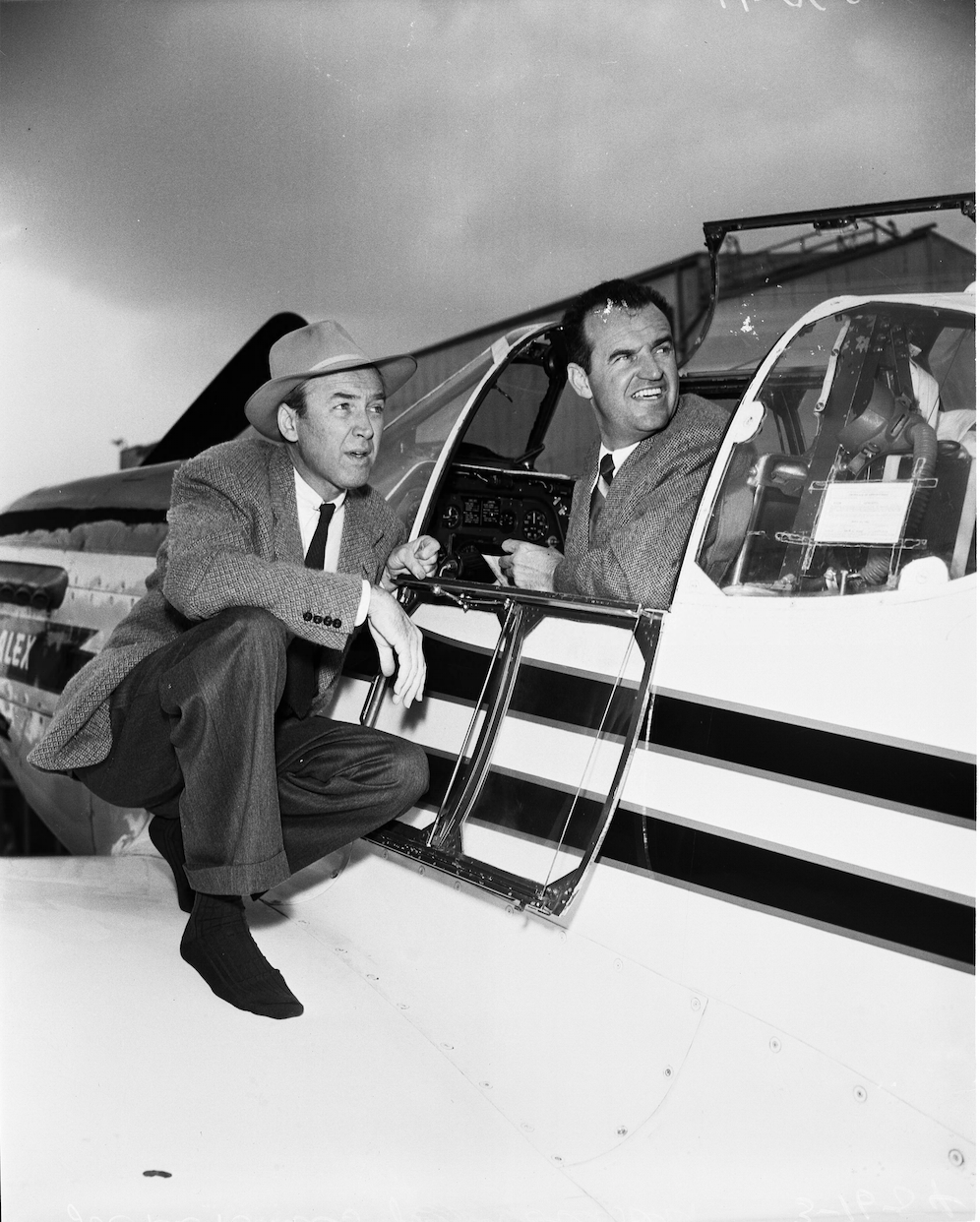
At about this time, N5528N was repainted in a yellow and black scheme, and renamed Mr. Alex in honor of Jimmy Stewart’s father, Alexander Maitland Stewart.
Thunderbird received another engine upgrade, this time to a Packard V-1650-9, serial number V381230. (This engine was rated at 1,380 horsepower at 3,000 r.p.m., but could produce a maximum 2,280 horsepower with water-alcohol injection.) The next airworthiness inspection was completed 31 March 1953 by a mechanic with certificate number M-17807. At the time of this inspection, N5528N had accumulated 76:00 hours total flight time (TTAF). The V-1650-9 engine had only 14:10 hours since new. C.A.A. Aviation Safety Agent Ralph C. Olsen approved the next airworthiness certificate.
A major event of 1953 was the Coronation of Elizabeth II on 2 June. American television networks CBS and NBC had arranged to have films of the ceremonies flown across the Atlantic to Newfoundland. From there the film would be flown on to the United States by Jimmy Stewart’s P-51 and another owned by Paul Mantz, NX1204, flown by Stanley Reaver.
Jimmy Stewart asked the C.A.A. to temporarily remove the limitations on NX5528N’s airworthiness certificate so that it could be flown out of the United States to pick up the films at Newfoundland and return with them to Boston, Massachusetts. C.A.A. Aviation Safety Agent Ralph C. Olsen approved this request. A second flight to Montreal, Canada was also authorized. The restrictions would resume when the Experimental category Mustang returned to the United States after the Montreal trip.Joe De Bona was once again in the cockpit of N5528N. He arrived at Boston 24 minutes before his rival, Stan Reaver, but a third network, ABC, was actually the first to broadcast the films of the Coronation.
On 30 March 1954, another airworthiness inspection was completed by the same mechanic as the 1953 periodic inspection. Once again, the airworthiness certificate was approved by Ralph Olsen. Total flight time for N5528N was now 118:00 hours, with 42:50 on the Merlin engine.
Attempting to set another transcontinental speed record, De Bona took off from Los Angeles International Airport at 7:18:08 a.m., Pacific Standard Time (14:18:08 UTC), 31 March 1954, and flew to Idlewild Airport in New York City. He landed there at 2:42:25 p.m., Eastern Standard Time (18:42:25 UTC). With an official elapsed time of 4 hours, 24 minutes, 17 seconds, the National Aeronautic Association credited him with a U.S. national record speed of 560.74 miles per hour (902.42 kilometers per hour).
On 1 September 1954, Jimmy Stewart sold N5528N to Joe De Bona for $1.00 plus a $7,500.00 Chattel Mortgage. On 14 March 1954, the C.A.A. registered the airplane, which they now designated as a North American F-51C, to De Bona at 339 North Beverly Drive, Beverly Hills, California.
An airworthiness inspection was completed 17 March 1955. The mechanic performing the inspection held certificate number M7427. The V-1650-9 had been removed and replaced with a Packard V-1650-300, serial number V350012. This post-war commercial engine was rated at 1,660 horsepower at 3,000 r.p.m. The airframe now had 150:00 hours TTAF, and the new engine had 30:00 hours.
The following day, 18 March 1955, Joe De Bona sold N5528N to James M. Cook of Jacksboro, Texas, for $18,000 plus a $7,000 Chattel Mortgage at 4% interest, payable on or before 1 January 1956. The C.A.A. issued a Certificate of Registration to Cook on 31 March 1955.
On 22 June 1955, Jim Cook was using the Mustang to seed clouds for a hail suppression program for Valley Hail Suppressors, Inc. Cook, in the cockpit of N5528N, took off from Scottsbluff, Nebraska, at about 6:00 p.m. He discovered that one of the main landing gear would not retract, nor could he lower the other. After trying to solve the problem for about an hour-and-a half, Cook decided that it was too dangerous to attempt a landing and bailed out. At 7:55 p.m., North American Aviation P-51C Mustang N5528N crashed 15 miles (24 kilometers) north and 3 miles (4.8 kilometers) east of Morrill, Nebraska (near Scottsbluff). The exploded on impact and the wreckage burned. A newspaper reporter who was at the scene said that the Mustang had opened a trench approximately 6 feet (1.8 meters) deep and 45 feet (13.7 meters) long. He described the airplane as “totally demolished,” with pieces thrown up to 100 yards (91 meters) away. The Merlin engine was “unrecognizable.”
Although an accident report was completed 13 July 1955, the Federal Aviation Administration currently has no report in its files, nor does the National Transportation Safety Board.
N5528N was deregistered 15 August 1955. (James Cook soon bought another Mustang, P-51D N71L, which he flew for several years as part of the U.S. Weather Bureau’s Thunderstorm Research Airplane Project.)
Warren A. Piestch of Pietsch Aircraft Restoration and Repair, Inc., Minot, North Dakota, purchased a tail wheel assembly and other parts from a wrecked P-51 located in Nebraska, 23 June 1999. He wrote to the F.A.A. and stated that these parts were from P-51 serial number 2925, and that he wanted to rebuild the aircraft. Pietsch requested that ownership of 2925 be assigned to him and that a registration N-number that he had previously reserved, N151LP, be assigned to the airplane. The F.A.A. did as Pietsch requested. That registration was valid until 30 April 2015. On 24 September 2007, 2925 was registered to Pietsch with its original “N number” of N5528N. That registration remains in effect. There is no current Airworthiness Certificate.
AirCorps Aviation of Bemidji, Minnesota, is currently “restoring” a P-51 for the Dakota Territory Air Museum, which they identify as the record-breaking Mustang, Thunderbird. (Warren Pietsch is a member of the museum’s board of directors.)
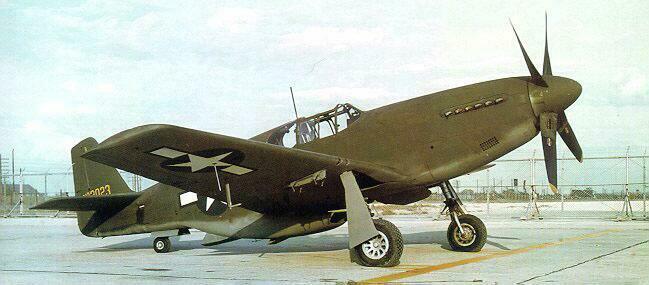
 The North American Aviation P-51 Mustang is a single-place, single-engine long range fighter. It is a low-wing monoplane with retractable landing gear and is of all-metal construction. The fighter is powered by a liquid-cooled V-12 engine. It was originally produced for the United Kingdom’s Royal Air Force as the Mustang Mk.I. Two examples were provided to the U.S. Army Air Corps, designated XP-51. This resulted in orders for the P-51A and A-36 Apache dive bomber variant. These early Mustangs were powered by the Allison V-1750 engine driving a three-bladed propeller, which also powered the Lockheed P-38 Lightning, Bell P-39 Airacobra and Curtiss-Wright P-40 Warhawk.
The North American Aviation P-51 Mustang is a single-place, single-engine long range fighter. It is a low-wing monoplane with retractable landing gear and is of all-metal construction. The fighter is powered by a liquid-cooled V-12 engine. It was originally produced for the United Kingdom’s Royal Air Force as the Mustang Mk.I. Two examples were provided to the U.S. Army Air Corps, designated XP-51. This resulted in orders for the P-51A and A-36 Apache dive bomber variant. These early Mustangs were powered by the Allison V-1750 engine driving a three-bladed propeller, which also powered the Lockheed P-38 Lightning, Bell P-39 Airacobra and Curtiss-Wright P-40 Warhawk.
In 1942, soon after the first production Mustang Mk.I arrived in England, Rolls-Royce began experimenting with a borrowed airplane, AM121, in which they installed the Supermarine Spitfire’s Merlin 61 engine. This resulted in an airplane of superior performance.
In the United States, the Packard Motor Car Company of Detroit, Michigan, had begun building Merlin engines under license from Rolls-Royce. These American engines were designated V-1650. North American modified two P-51s from the production line to install the Packard V-1650-3. These were designated XP-51B. Testing revealed that the new variant was so good that the Army Air Corps limited its order for P-51As to 310 airplanes and production was changed to the P-51B.
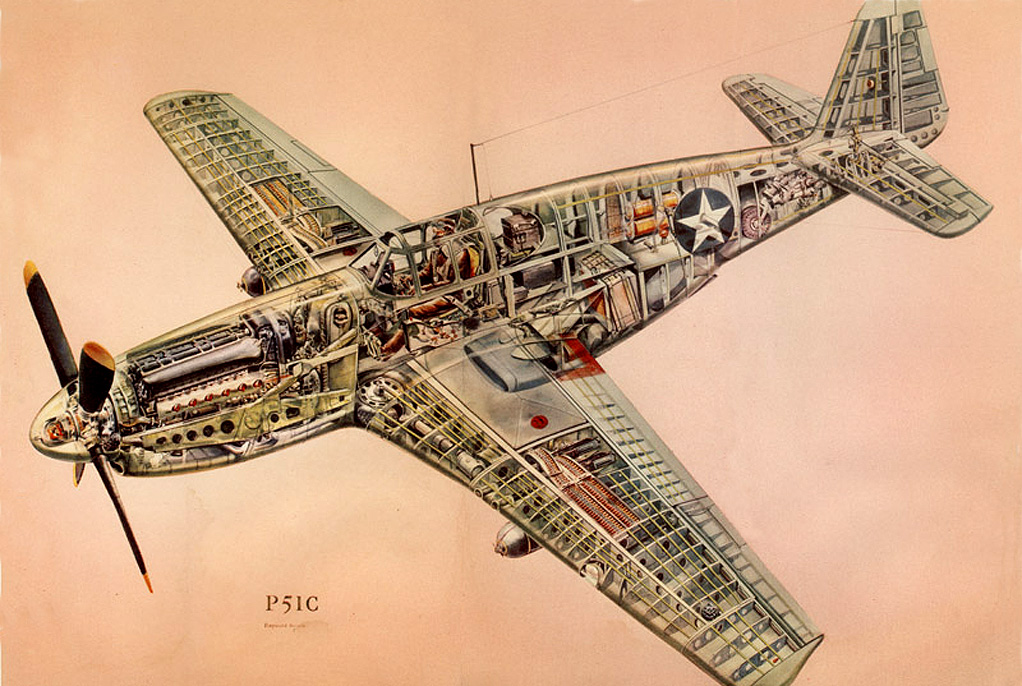
The P-51B and P-51C are virtually Identical. The P-51Bs were built by North American Aviation, Inc., at Inglewood, California. P-51Cs were built at North American’s Dallas, Texas plant. They were 32 feet, 2.97 inches (9.829 meters) long, with a wingspan of 37 feet, 0.31-inch (11.282 meters) and overall height of 13 feet, 8 inches (4.167 meters) high. The fighter had an empty weight of 6,985 pounds (3,168 kilograms) and a maximum gross weight of 11,800 pounds (5,352 kilograms).
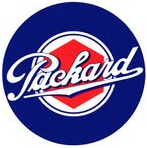 P-51Bs and Cs were powered by a right-hand tractor, liquid-cooled, supercharged, 1,649-cubic-inch-displacement (27.04-liter) Packard V-1650-3 or -7 Merlin single overhead cam (SOHC) 60° V-12 engine which produced 1,380 horsepower at Sea Level, turning 3,000 r.p.m at 60 inches of manifold pressure (V-1650-3) or 1,490 horsepower at Sea Level, turning 3,000 r.p.m. at 61 inches of manifold pressure (V-1650-7). (Military Power rating, 15 minute limit.) These were license-built versions of the Rolls-Royce Merlin 63 and 66. The engine drove a four-bladed Hamilton Standard Hydromatic constant-speed propeller with a diameter of 11 feet, 2 inches (3.404 meters) through a 0.479:1 gear reduction.
P-51Bs and Cs were powered by a right-hand tractor, liquid-cooled, supercharged, 1,649-cubic-inch-displacement (27.04-liter) Packard V-1650-3 or -7 Merlin single overhead cam (SOHC) 60° V-12 engine which produced 1,380 horsepower at Sea Level, turning 3,000 r.p.m at 60 inches of manifold pressure (V-1650-3) or 1,490 horsepower at Sea Level, turning 3,000 r.p.m. at 61 inches of manifold pressure (V-1650-7). (Military Power rating, 15 minute limit.) These were license-built versions of the Rolls-Royce Merlin 63 and 66. The engine drove a four-bladed Hamilton Standard Hydromatic constant-speed propeller with a diameter of 11 feet, 2 inches (3.404 meters) through a 0.479:1 gear reduction.
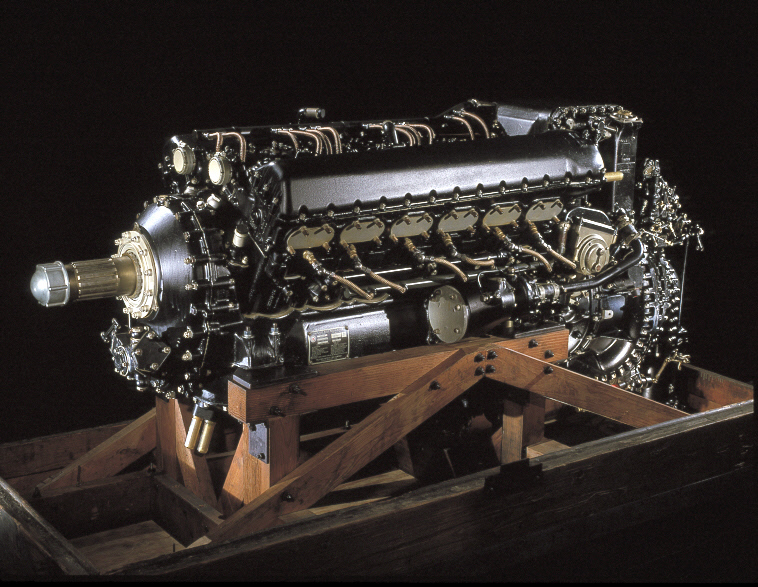
The P-51B/C had a cruise speed of 362 miles per hour (583 kilometers per hour) and the maximum speed was 439 miles per hour (707 kilometers per hour) at 25,000 feet (7,620 meters). The service ceiling was 41,900 feet (12,771 meters). With internal fuel, the combat range was 755 miles (1,215 kilometers).
In military service, armament consisted of four Browning AN/M2 .50-caliber machine guns, mounted two in each wing, with 350 rounds per gun for the inboard guns and 280 rounds per gun for the outboard.
1,988 P-51B Mustangs were built at North American’s Inglewood, California plant and another 1,750 P-51Cs were produced at Dallas, Texas. This was nearly 23% of the total P-51 production.
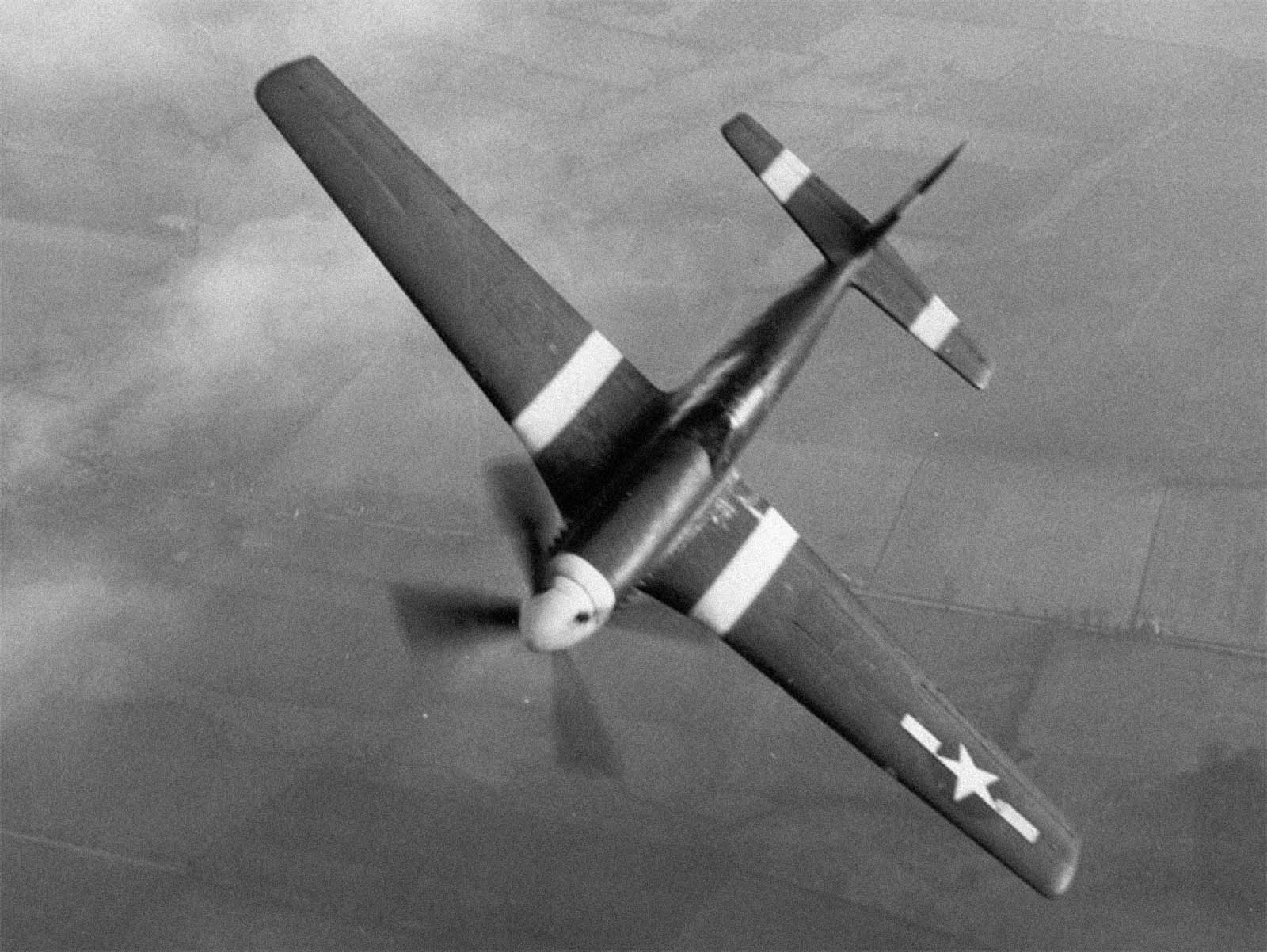
© 2023, Bryan R. Swopes
